Let’s get something clear right off the bat: there really aren’t any free email marketing platforms.
The free plans I go over are generous enough that you can try out the platform to its fullest extent or use them to get your email marketing strategy off the ground.
I’ll point out the free features, as well as the pricing plans, in case you wish to scale your business as it grows in the future.
So, let me provide you with a snapshot of the platforms I’ve researched and compared, then I’ll break down my comparison criteria, and finally, get down with detailed reviews.
Disclaimer: The references to software ratings, available features, and pricing were valid at the time of writing this article but could be subject to change in the future.
Best free email marketing platforms: a snapshot
Click on a platform name to jump ahead to the detailed review.
- Mailtrap Email Delivery Platform is best for product companies with large email sending volumes looking for a high inboxing rate and industry-best analytics.
- Brevo for teams who plan to send a small amount of emails every day or those who want to send newsletters.
- GetResponse for small and medium sized businesses, due to its robust list of features and scalable plans.
- Mailchimp for small businesses looking to kickstart their email marketing.
- MailerLite for businesses new in the email marketing world and those who plan to send newsletters.
- Moosend for SMBs that are looking for advanced automation workflows, a wide variety of email template designs, unlimited email sends, and scalable pricing.
- Omnisend for online store owners who are looking for email marketing software geared towards e-commerce.
- Klaviyo for those who want to send SMS messages and push notifications along with their email marketing campaigns.
- HubSpot for people who need a CRM, plethora of integrations, automations, and a marketing suite all in one place.
And for your convenience, here’s a table with a brief overview of each email marketing platform:
| Platform | Free plan limits | Notable features | Pricing* |
| Mailtrap | 4,000 emails/month, 100 contacts | High deliverability by design, industry best analytics, human 24/7 support | $15 for 10,000 emails and up to 25,000 contacts |
| Brevo | 300 emails per day, 500 contacts | Free email newsletter software, WordPress plugin | From $9 for 5000 emails and up to 500 contacts |
| GetResponse | 2,500 emails per month, 500 contacts | Forms and popups, autoresponders, automations, segmentation | From $19 for unlimited emails and up to 1,000 contacts |
| Mailchimp | Up to 1,000 emails/month, 500 contacts | Landing page templates, intuitive campaign builder | From $13 for 5,000 emails and 500 contacts |
| MailerLite | Up to 1,000 sends/month, 500 contacts | Automation workflows, landing page builder | From $10 for unlimited emails and up to 500 subscribers |
| Moosend | Unlimited email sends for the first 30 days | Advanced automations, no-code email builder, wide variety of templates | From $9/month for unlimited emails and up to 1,000 |
| Omnisend | 500 emails/month, 250 contacts, $1 free in SMS | E-commerce integrations, sales & performance tracking | From $16 for 6,000 emails and 500 contacts |
| Klaviyo | 500 emails/month, 250 contacts, 150 SMS/MMS credits | Automation templates, sign-up form templates | From $30 for 10,000 emails and 500-1000 contacts |
| HubSpot | 2,000 emails/month, 1,000 contacts | Plethora of integrations, various builders | From $20 for 5,000 emails and 1,000 contacts |
Free email marketing services comparison criteria
Email Infrastructure
I think that a solid email infrastructure is the core of any email marketing platform out there, and a solid infrastructure consists of three key components: deliverability, reliability, and scalability.
Deliverability
In short, email deliverability is the actual ability of an email marketing platform to get your emails to reach the recipient’s inbox. To achieve this, a platform needs to have proper authentication protocols in place, use dedicated IPs and warm them up before sending, and more.
It’s also important to note that some email marketing platforms upsell this and make deliverability a part of their paid plans. And since I want your emails to land in inboxes, I won’t be including such platforms in this article.
Reliability
In short, reliability is the ability of a platform to consistently deliver your emails without hiccups, downtimes, or other major issues. The platform you choose needs to have an infrastructure that will reliably perform even during peak times.
Frankly, it’s 2025, so, naturally, you expect uptime to be 99.9%. And you’re absolutely right. However, I’ve checked the status pages like this one just in case and scoured the web for comments saying a platform is down, like this one, for example. Fortunately, everything works as intended.
Scalability
Scalability, or how an email marketing platform can allow you to scale and grow your business, is concerned mostly with the higher plans and operations with plans of sending large volumes of email.
However, I take it into consideration here because, more often than not, people will use a free email marketing campaign to get their campaigns off the ground, then switch to a paid plan to scale up.
It’s also important to note that scalability is not just the number of emails sent but also the number of emails delivered. So, you can also look at scalability as “cost per delivered email.”
AI, email automation, and integrations
AI in email marketing
AI is widely used in email marketing for automatic audience segmentation or generating email content and subject lines, for instance.
Moreover, email marketing platforms leverage AI for:
- Landing page builders
- Template builders
- Workflow builders
- And more
That’s why I’ve tried to include as many email marketing platforms that offer free AI features. I’ve tried them out, compared them all, and can now tell you with certainty whether a platform is offering a gimmick or an actually useful AI tool.
Automation
Automating your email workflow is like setting a plane to autopilot. Not only does it do the work for you, but it operates more efficiently than you—after all, you’re not really going to wake up at 5 AM to send a welcome email when a user from a different timezone registers for your website.
The platforms I included in this article allow you to automate:
- Welcome email series
- Re-engagement emails
- Abandoned cart reminders
- Customer retention emails
- Order confirmation emails
- And more
Also, did you know you can use AI for email automation? Yep, that’s right. Feel free to check out the video our YouTube team prepared on the topic:
Integrations
Integrating other apps with your chosen platform is typically free and allows you to improve your marketing funnel in various ways and get one step closer to your customers on their journey.
Some platforms on this list have a wide range of integrations, while others, for example, have only those specific for e-commerce. Whatever your preference might be, I’ll be sure to mention them so you can keep an eye out.
Email design
Drag-and-drop email builder
Even if you’re someone who likes creating HTML emails from scratch, you can’t deny that drag-and-drop email builders make life easier.
With a good drag-and-drop email builder, you can quickly rearrange your email according to your liking, play around with the layout, and preview mobile and desktop versions—all without having to go anywhere near your preferred code editor.
So, I’ve made sure to include only free email marketing software with drag-and-drop email builders that allow you to do all of the above and more. However, keep in mind that they all have email branding, which has unfortunately become the industry standard.
Important: All email marketing platforms insert branding for free plan users. This means that if you want to send emails without having, for example, ‘powered by Brevo’ at the bottom of them, you’ll have to switch to a paid plan.
Email templates library
Some email marketing platforms might say that they offer a plethora of email templates, whereas they lock them for paid plans. On the other hand, there are platforms that let you use all of their templates for free, but they are not that great.
However, if you’re into email templates, there are a few platforms on this list that don’t tick either of the boxes above and instead offer great free templates for every occasion.
Email analytics
Launching campaigns and sending out emails without any analytics or reporting would be like shooting in the dark. To ensure your campaigns are doing well, that they’re healthy, and to see if there’s something you can improve, you need to know key email marketing metrics. Some of these include:
- Open rate
- Click-through rate
- Bounce rate
- Unsubscribe rate
- Conversion rate
For example, if you see that your bounce rate is high (~2% or higher), you should try cleaning your email list or checking if there’s a weak link in your email infrastructure.
However, different platforms leverage analytics differently; so I tested them to find the most insightful ones. It’s pretty subjective, still, I tried to evaluate dashboards as objectively as possible.
User experience
When I talk about user experience, I talk about 4 different aspects of it, primarily:
- Ease-of-use – How easy is it for a new user to get the ropes of a platform, how convenient is it to launch the campaign, and how much time do I spend launching one?
- Ease-of-integration – Do I need to be a developer to integrate my favorite app with the email marketing platform? Or, can I integrate it in a few easy clicks?
- Documentation – Does the email marketing platform offer a knowledge base with articles that can help me along the process of sending email campaigns or dealing with potential issues I encounter along the way? Is there documentation my dev team can consult to use the API or any of the other technical components of the platform?
- Customer support – Can I get in touch with the platform’s customer support team in more than one way, preferably via live chat or a ticket system? Will the customer support answer if need be and do they work around the clock to meet the needs of users all around the globe?
Legal compliance and security
To spare you the technical details, I’ve made sure to include only email marketing platforms that can help you comply with regulations like GDPR (EU), CCPA and CPRA (US), and so on.
But how can an email marketing platform help you comply with a regulation? Well, for example, if it includes an obligatory unsubscribe link in your emails, you will automatically be compliant with the CAN-SPAM Act.
As far as the security goes, I’ll check which email encryption the platforms on this list use (e.g., TLS, HTTPS, AES 256, etc.).
Customer experience
For each email marketing solution, I will go through online customer testimonials and reviews on websites such as G2, Capterra, and Trustpilot.
Additionally, I’ll make sure to check out what the comments on social media say about each of these platforms because you can find a great deal about a platform that way. For instance, no platform will admit they have unresponsive customer support, but the customers will definitely report that on social media.
Pricing
While you’re using the free plan, you can check how the platform performs deliverability-wise, and how you like it overall. Then, if it turns out it fits your business’ needs, you’ll probably want to get a paid plan to get the most out of it.
Also, when you’re paying for email marketing software, you want it to allow your business to grow and you want it to be able to handle different email-sending volumes. That’s why I’ve included pricing tables so you can compare the different tiers yourself and see what’s within your budget.
Best free email marketing service provider: Mailtrap Email Delivery Platform
Free plan: 4,000 emails per month (Email API/SMTP), 100 contacts
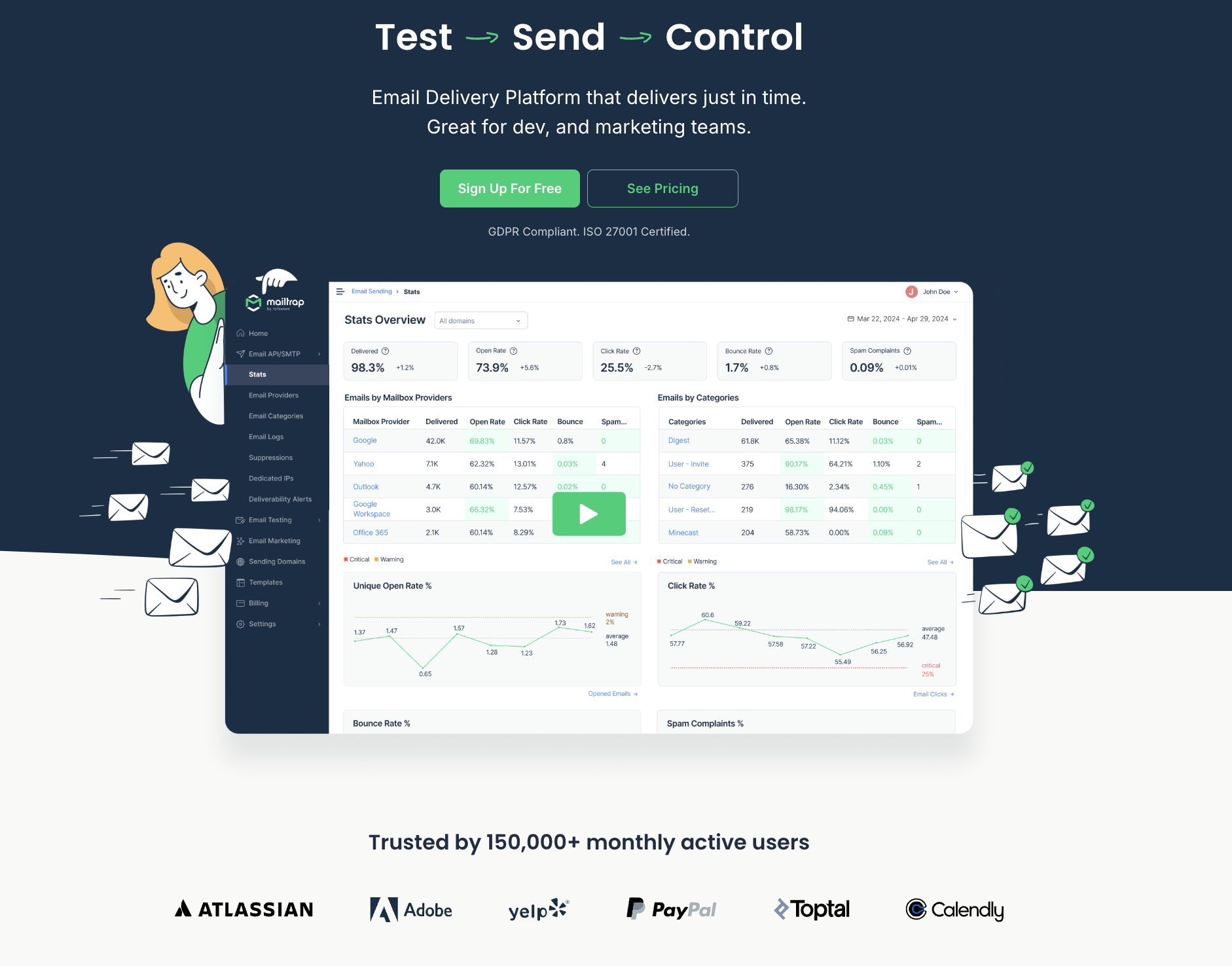
Mailtrap is a high-deliverability email platform for product companies who are looking to send marketing, mass, and transactional emails at scale with industry best analytics.
Speaking of analytics, you get helicopter view dashboards and drill-down reports with which you can keep an eye out on the performance of your campaigns from various angles.
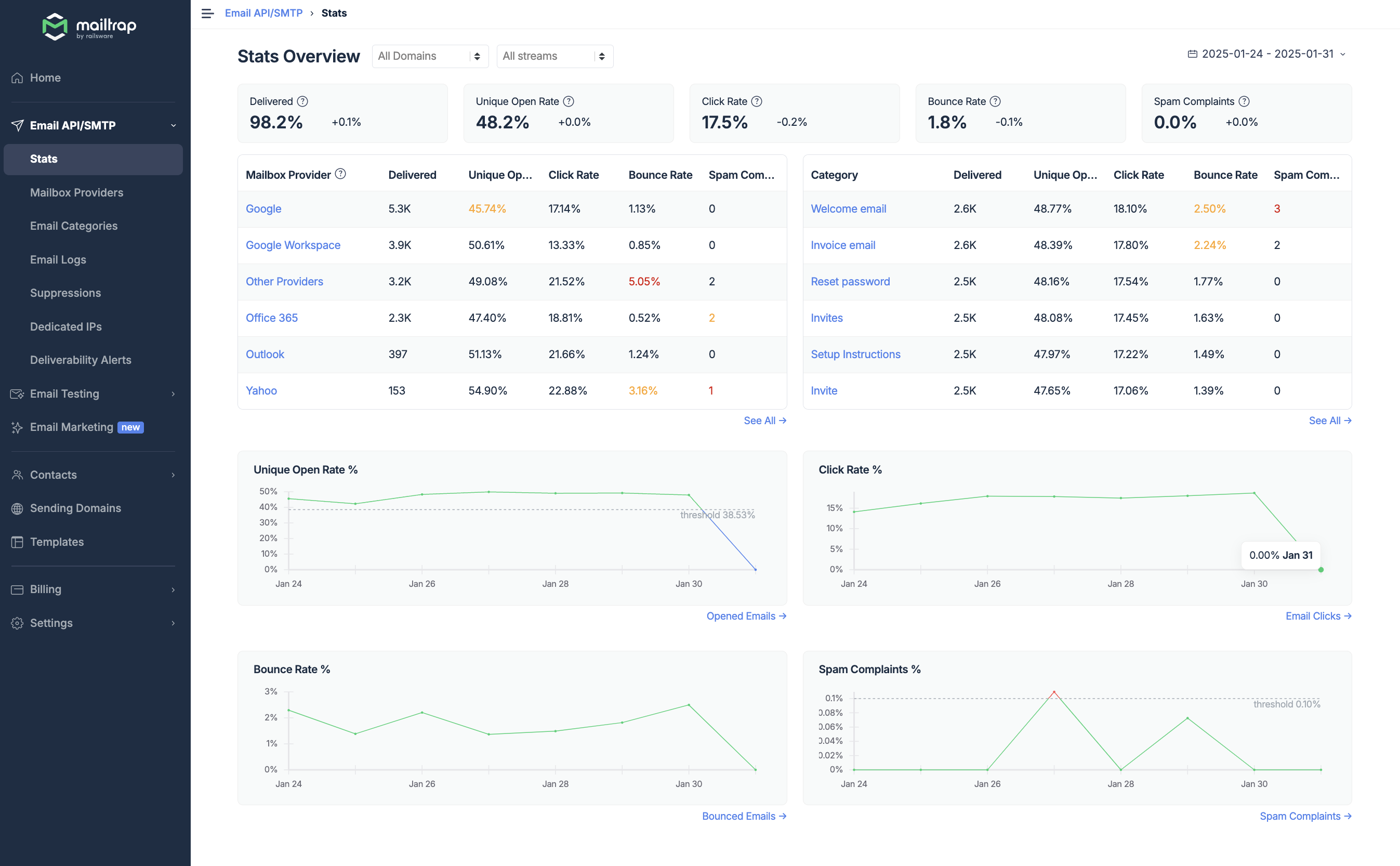
Additionally, we’ve recently tested several platforms to see what % of emails will reach the recipients. The tests were as fair as possible, meaning we used the free plans, didn’t warm up domains, used the same email template, and more.
Here’s how Mailtrap performed in the benchmark:
| Platform | Email placement results | Spam filter rating | Inbox email delivery with top providers |
| Mailtrap | Inbox: 78.8% Tabs: 4.8% Spam: 14.4% Missing: 2.0% | Google Spam Filter: Not spam; Not phishy Barracuda: Score 0 Spam Assassin: Score: -3.8 | Gmail: 67.50% Outlook: 77.78% Hotmail: 100% Yahoo: 55.56% |
For the full results and insights into the methodology we used, check out our dedicated blog post on email deliverability comparison. ⬅️
And yes, you’ll hit inboxes even on the free plan, as high deliverability rates are included by design. This makes Mailtrap great for startups and solopreneurs who are looking to save a few bucks but still have their emails land in their recipients’ inboxes.
Moreover, with the the free plan, you get access to:
- Drag-and-drop editor
- Email templates
- Email logs
- Contacts list management
- Campaign scheduling
- Email API/SMTP
Lastly, I must mention that all customers get access to 24/7 human customer support regardless of their plan.
Pricing
Now, when it comes to actual paid plans, you can choose from a variety of them. Namely:
| Plan | Monthly cost | Email limit | Contacts | Key features |
| Free | $0 | Up to 4,000 emails | Up to 100 contacts | SMTP relay, email API, drag-and-drop editor, webhooks |
| Basic | From $15 | 10,000+ emails | Up to 50,000 contacts | Email logs (5 days), body retention, click-rate tracking, HTTPS link branding |
| Business | From $85 | 100,000+ emails | Up to 750,000 contacts | Email logs (15 days), dedicated IP, auto warm-up |
| Enterprise | From $750 | 1,500,000 emails | Up to 5,000,000 contacts | All of the above + priority support and 30 days email log retention |
| Custom | Custom | From 1,500,000 | Unlimited | All of the above |
Pros & cons
Pros:
- High deliverability rates
- In-depth analytics
- Straightforward setup process
- In-built AI for generating images and text
- Extensive documentation for your development team
- 24/7 customer support
- Scalable pricing
Cons:
- Free plan accounts are limited to only one user and don’t allow team members
- There is no dedicated IP or SSO on the free plan
User experience
Overall, setting up Mailtrap is quite easy as all you have to do is verify your domain, which takes ~5 minutes. Then, you can proceed to create and launch your email marketing campaign. This, if you have a campaign in mind already, can take as little as ~15 minutes.
The drag-and-drop editor is super straightforward to use, importing your contacts and segmenting them into lists takes 2 buttons, and you can also have the in-built AI generate images or texts for headings and such.
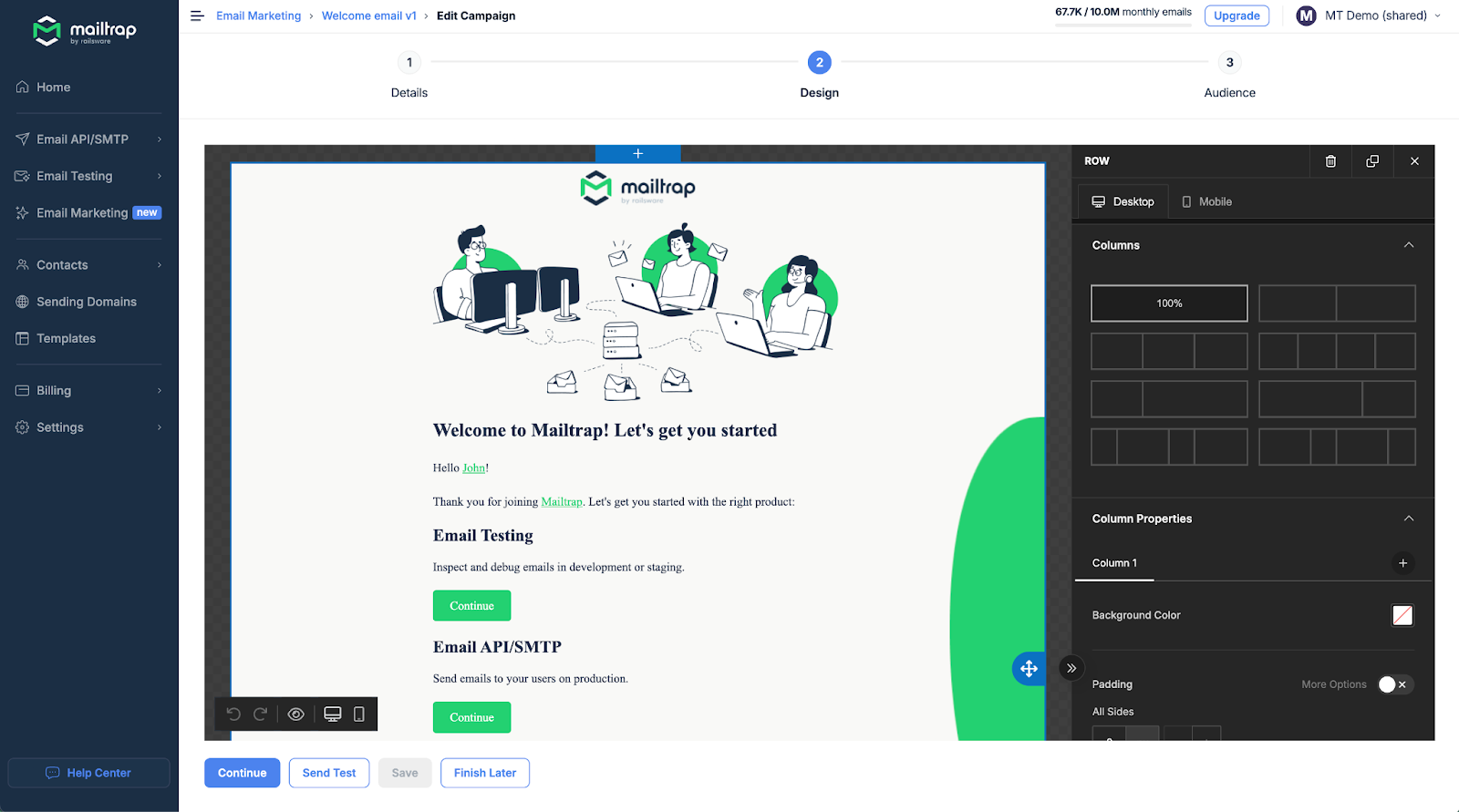
There’s also the huge Knowledge Base that’s regularly updated with new articles, as well as a plethora of helpful videos on all things email on the official YouTube channel. 👀
Customer experience
It’s always nice to see that Mailtrap gets love on the web, so here are my favorite love rants I found:


Brevo
Free plan: 300 emails per day, 500 contacts
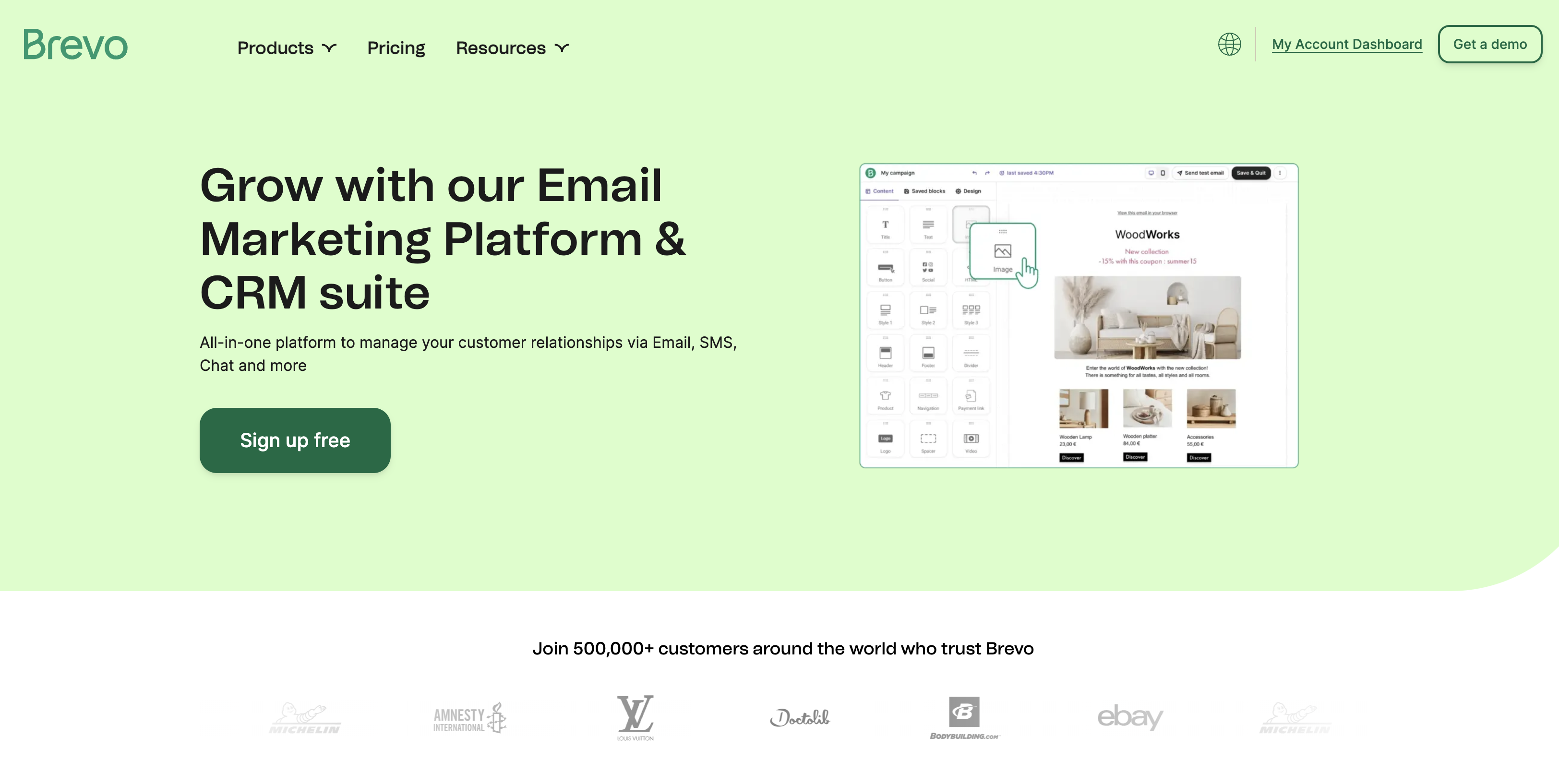
Brevo is a five-in-one platform for relationship marketing, with one of its suites being dedicated to email marketing. The platform’s free plan is perfect for small-time senders or those who want to send newsletters.
Namely, with Brevo’s free newsletter software you can:
- Create mobile-friendly emails using the intuitive drag and drop editor
- Code emails from scratch using the HTML editor
- Use one of 40+ newsletter email templates (these all look great, and there’s one for every occasion)
- Generate subject lines with AI assistance
- Analyze your newsletter’s performance in real-time
Additionally, you can set up abandoned cart reminders or integrate Brevo with your WordPress website using the official WP plugin.
Pricing
Brevo has scalable pricing that should accommodate most businesses. Check it out:
| Plan | Monthly Cost | Email Limit | Contacts | Key features |
| Free | $0 | 300 per day | 500 | Automation templates, API/SMTP, webhooks, drag and drop editor |
| Starter | $9 | From 5000/month | Up to 500 | Basic reporting and analytics, 24/7 email support |
| Business | $18 | From 5000/month | 500, 1,500, or 500,000 | A/B testing, advanced statistics, phone support |
| Enterprise | Custom | Custom | Unlimited | Tailored onboarding, priority support, advanced integrations |
Pros:
- Automation templates for every occasion
- Free e-book about B2C marketing automation
- Transactional emails
- SMS marketing
- WordPress plugin
- Free sales CRM
Cons:
- Multiple users are allowed only on higher-tier plans
User experience
Brevo has one of the cleanest dashboard’s out there, and everything is laid out nicely. I didn’t have to spend much time searching for anything and launched a test campaign in ~15 minutes. Yes, there were a few hiccups with templates, but besides that, everything went smoothly.
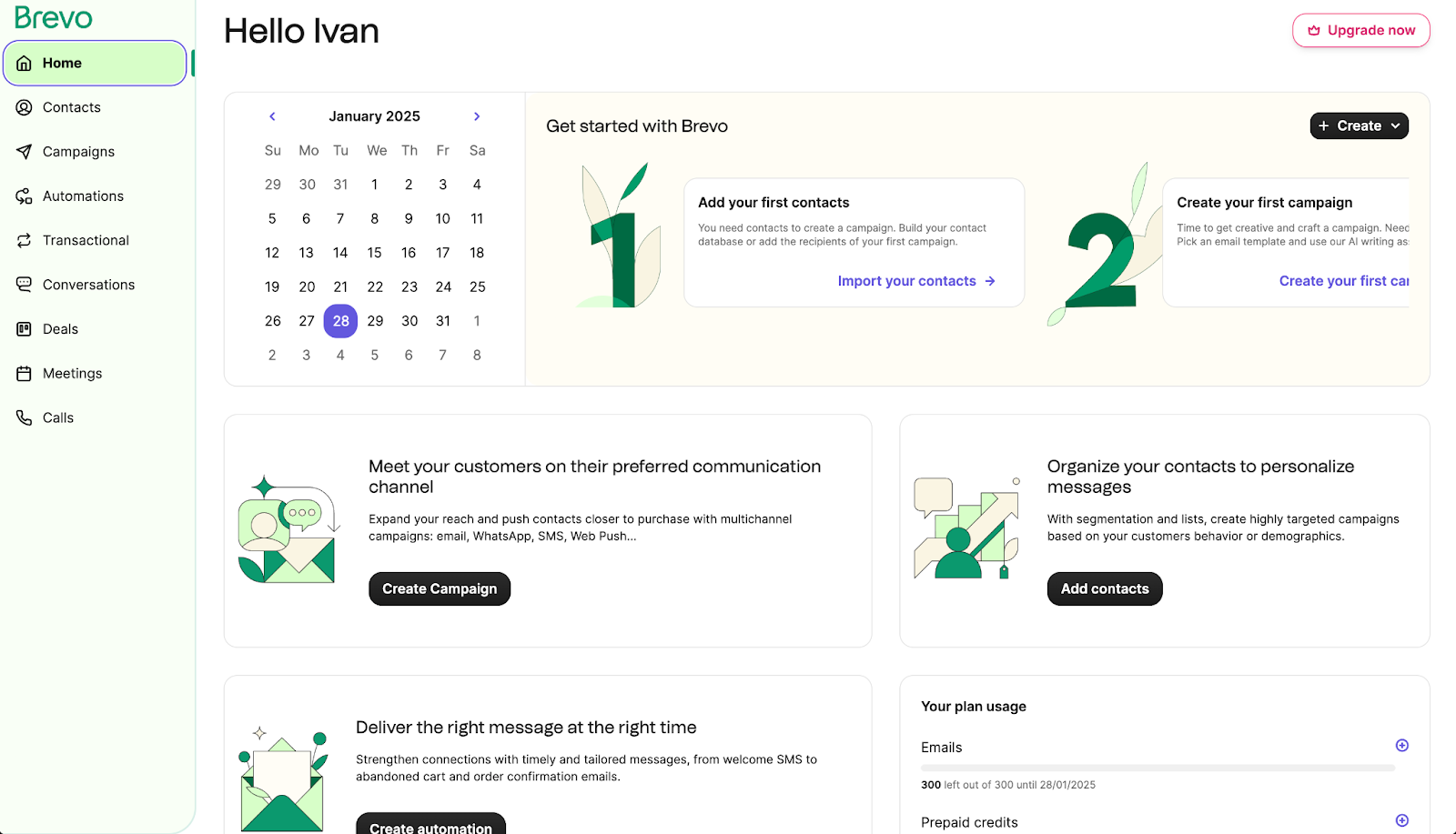
Additionally, in an industry where some platforms make automations super complicated (looking at you, Mailjet), Brevo does the opposite. Its automation builder is one of the most straightforward ones I have ever tried. Check it out:
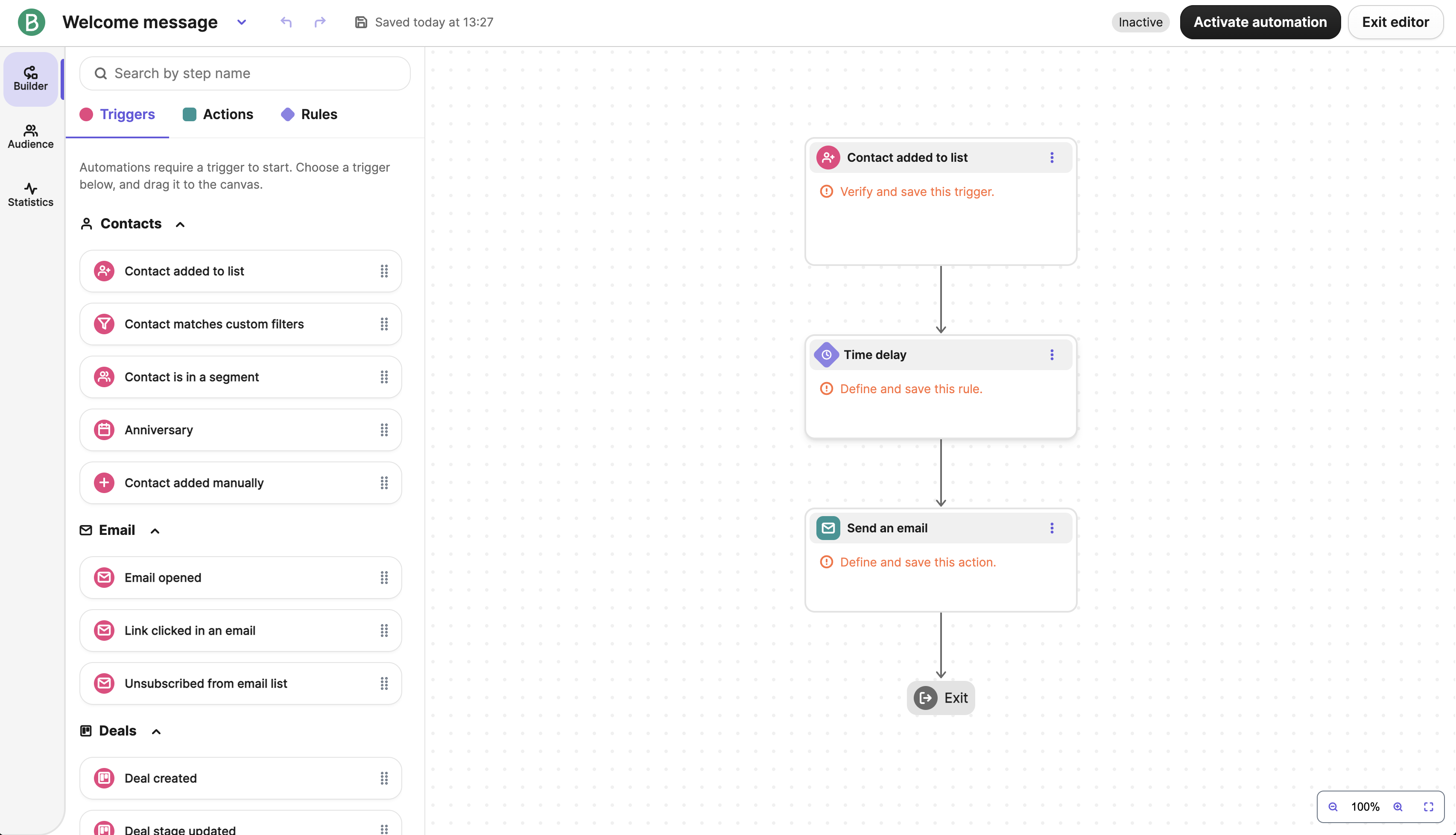
Overall, I’d say Brevo is one of the most user-friendly platforms out there. It’s not trying to waste your time with a steep learning curve and it also has an extensive knowledge base, free e-books, and more.
Customer experience
In terms of online love, Brevo is similar to MailerLite since it has outstanding reviews on Trustpilot and other review websites.
Moreover, I’ve noticed that people praise Brevo’s free plan on social media.
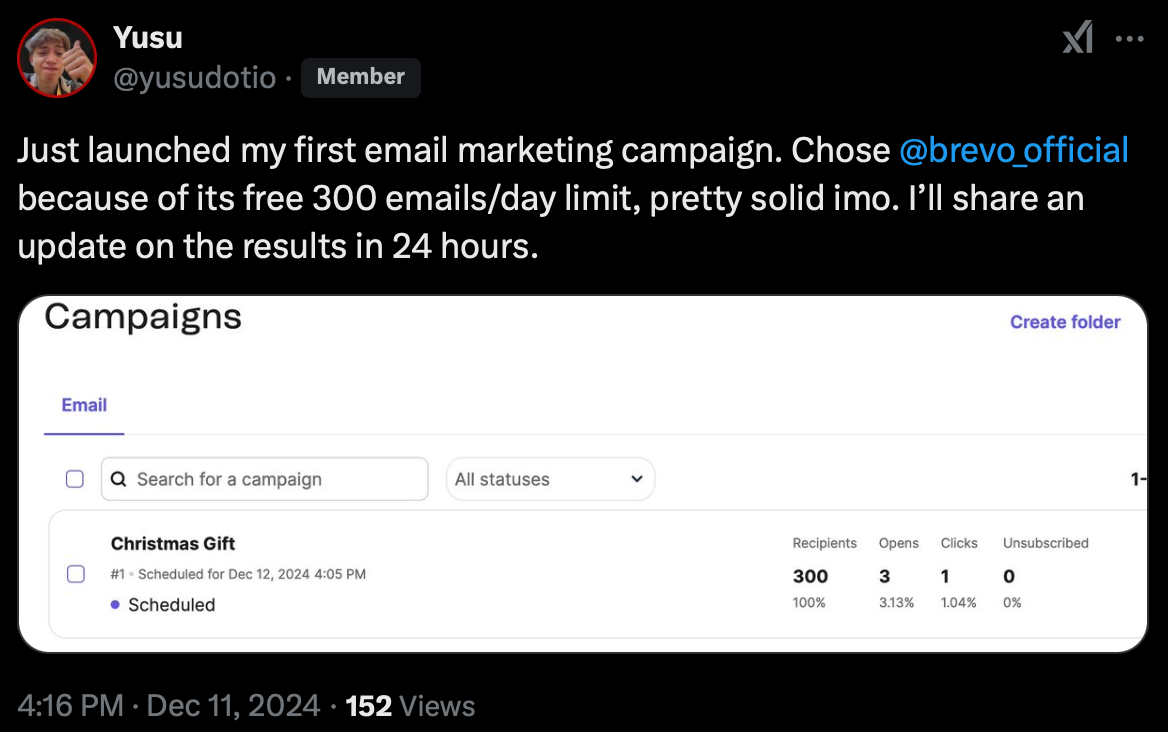
GetResponse
Free plan: 2,500 emails per month, 500 contacts

GetResponse is an email marketing and marketing automation platform that helps businesses grow through owned channels, including email, popups, landing pages, SMS, and more.
The platform’s most suitable for small and medium sized businesses, due to its robust list of features and scalable plans.
If you’re just getting started, you’ll want to try GetResponse’s free plan, which includes:
- Drag-and-drop editor
- Email reports
- Forms and popups
- Contacts
- 30 day access to premium features
In addition, you can create autoresponders and marketing automation workflows, which you can save as drafts until you commit to a paid plan.
Pricing
GetResponse offers several pricing plans which also scale as your list grows:
| Plan | Monthly Cost | Email Limit | Contacts | Key Features |
| Free | $0 | 2,500 per month | 500 | Drag-and-drop editor, reports, limited-time access to premium features |
| Starter | $19 | Unlimited | Up to 1,000 | AI email generator, AI landing pages, autoresponders, forms and popups, 24/7 live chat and email support |
| Marketer | $59 | Unlimited | Up to 1,000 | Marketing automation, e-commerce automations, advanced segmentation, web push notifications |
| Creator | $69 | Unlimited | Up to 1,000 | AI course builder, premium newsletters, webinars, website builder |
| Enterprise | Custom | Custom | Unlimited | Premium priority support, dedicated IP address, SSO, SMS marketing, transactional emails, AI product recommendations |
Pros:
- Multichannel automation capabilities
- Ecommerce automations and integrations
- Built-in lead generation tools, including popups, landing pages, and webinars
- Transactional emails
- SMS marketing
Cons:
- Features like SMS and transactional emails are only available in the custom Enterprise plan
- Steeper learning curve than with some other email-only platforms
User experience
GetResponse offers a modern and intuitive dashboard, which includes customizable widgets you can adjust to fit your business’ needs.

If you’re just getting started, the platform might feel a bit intimidating due to the number of features available in the Tools tab. However after spending several minutes clicking through them, you’ll know which ones you’ll most frequently use.

And if you ever get stuck, you can visit the Explore tab, which includes personalized tutorials and checklists, or you can book a free onboarding session available with all paid plans.
As for drag-and-drop editors, which include the email builder, landing page builder, and automations, they all feel modern and work smoothly. Naturally, they also come with prebuilt templates and all the necessary documentation you’ll need to get around.

Customer experience
Looking at GetResponse’s reviews, you can see that their customers especially value their responsive customer support and comprehensive features. At the same time, some users report that the tool has a steeper learning curve than some other, more simpler platforms.

Mailchimp
Free plan: Up to 1,000 sends per month and 500 contacts
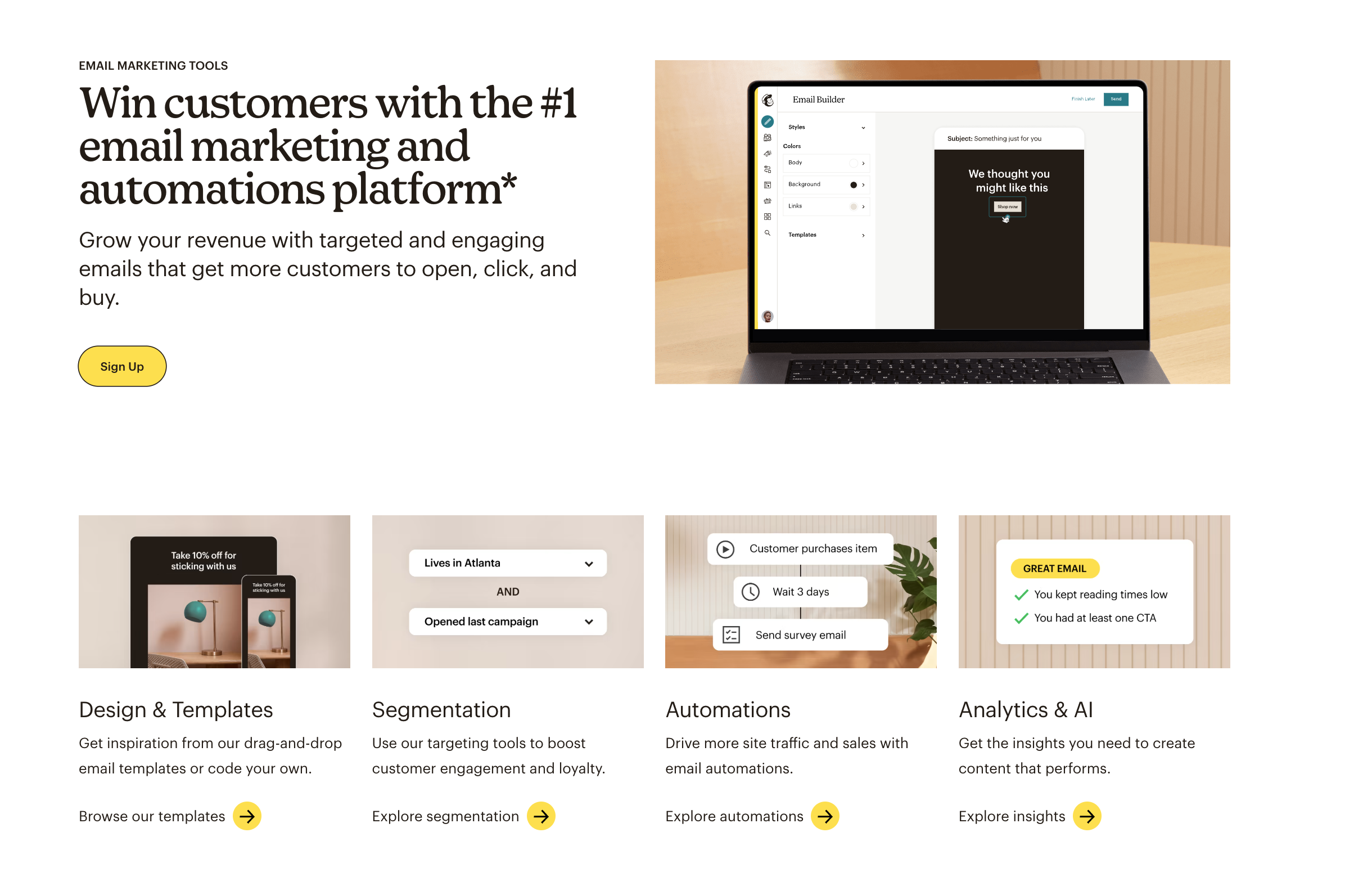
Mailchimp started out in 2001 as an email marketing service for small businesses and has since grown to own 60% of the market. The platform is still most suitable for small businesses looking to get their email marketing strategy off the ground.
This is primarily because with Mailchimp’s free plan, you get reports on your campaigns’ performance, and you can create landing pages and forms, amongst other things. The selection of landing page templates is also a nice touch.

However, automation features and inbox previews are locked, but you still get the quirky branding and user-friendliness for free!
Pricing
Although you can make good use of Mailchimp without paying a dime, if you’re considering upgrading in the future, keep in mind the price jump. 📈
For instance, you start off with 500 contacts at first to get the feel of the platform. One month passes, you want to import the rest of your contacts, and, let’s say, you have 5,000 contacts — not too shabby, right?
However, for 5,000 contacts, you’d have to pay $110/per month for the Essentials plan.
Nonetheless, here’s a table with compared pricing plans:
| Plan | Monthly Cost | Email Limit | Contacts | Key features |
| Free | $0 | Up to 1,000 | Up to 500 | Basic segmentation, audience dashboard, basic templates, content studio |
| Essentials | From $13 | 10X contacts | Up to 500 | Role-based access, limited analytics |
| Standard | From $20 | 12X contacts | Up to 500 | Generative AI features, custom templates, priority customer support, drip campaigns |
| Premium | From $350 | 15X contacts | 10,000 contacts | All of the above + phone support |
Pros:
- A variety of easy-to-edit automation templates
- User-friendly drag-and-drop editor
- Tips for content optimization and design
- Stable infrastructure with low downtime
- SMS support
- AI email writer
Cons:
- Price jump when you move to a paid plan
- No campaign scheduling nor customer support with the free plan
User experience
When it comes to creating campaigns, Mailchimp really is straightforward. You have everything laid out for you on a clean user interface, and after some clicks, you get what you want.

However, you can reach out to Mailchimp’s customer support team only during the first 30 days from the moment you create your account and only via mail.
MailerLite
Free plan: Up to 1,000 sends per month and 500 contacts
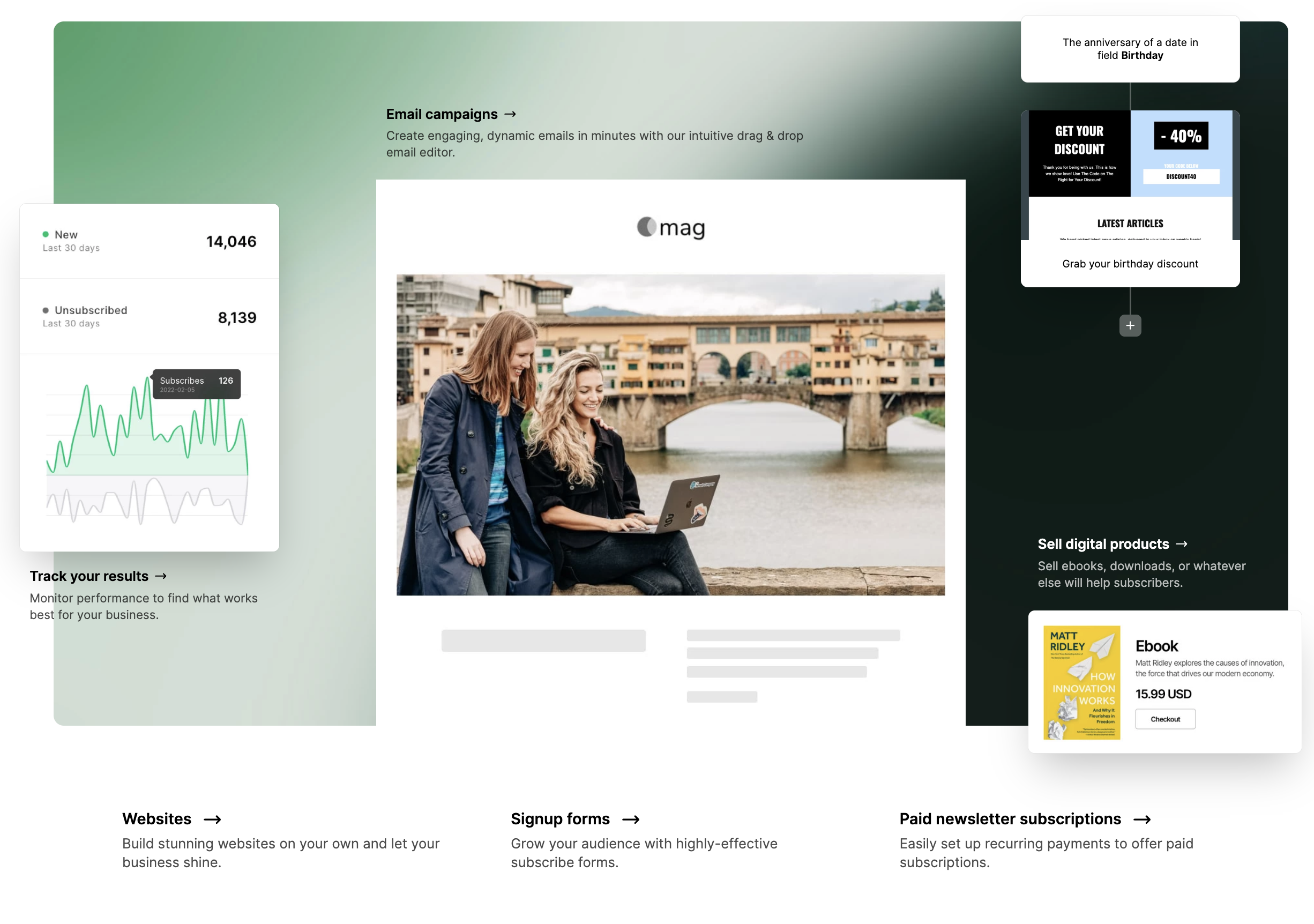
MailerLite is an email marketing platform that, as its name suggests, offers a simple-to-use service that does its job as promised and doesn’t require expert knowledge.
Due to its short learning curve, MailerLite is best for beginners in the email marketing world, as well as those who plan to send a decent amount of emails every month to a limited number of contacts on the free plan.
However, the free plan is generous in features, as you can:
- Build landing pages
- Create automation workflows
- Insert surveys into your campaigns
Additionally, for the first 30 days, you get to explore all of the premium features before you get switched to a stripped-down free plan.
Pricing
Although they’ve gone up in pricing lately, MailerLite is still affordable. Check it out:
| Plan | Monthly Cost | Email Limit | Contacts | Key features |
| Free | $0 | 12,000 per month | Up to 1,000 | Drag and drop email editor, automation builder, 10 landing pages, signup forms |
| Growing Business | From $10 | Unlimited | Up to 500 | Dynamic email templates, campaign auto-resend, unlimited landing pages |
| Advanced | From $20 | Unlimited | Up to 500 | AI writing assistant, HTML editor, Facebook integration, partner discounts |
Pros:
- Super straightforward to use
- Generous sending limit
- Automation tools (available for free)
- Easy segmentation with lists
- Basic reporting
- Autoresponders
- Basic website builder
Cons:
- No email templates on the free plan
- You cannot test your emails against spam
User experience
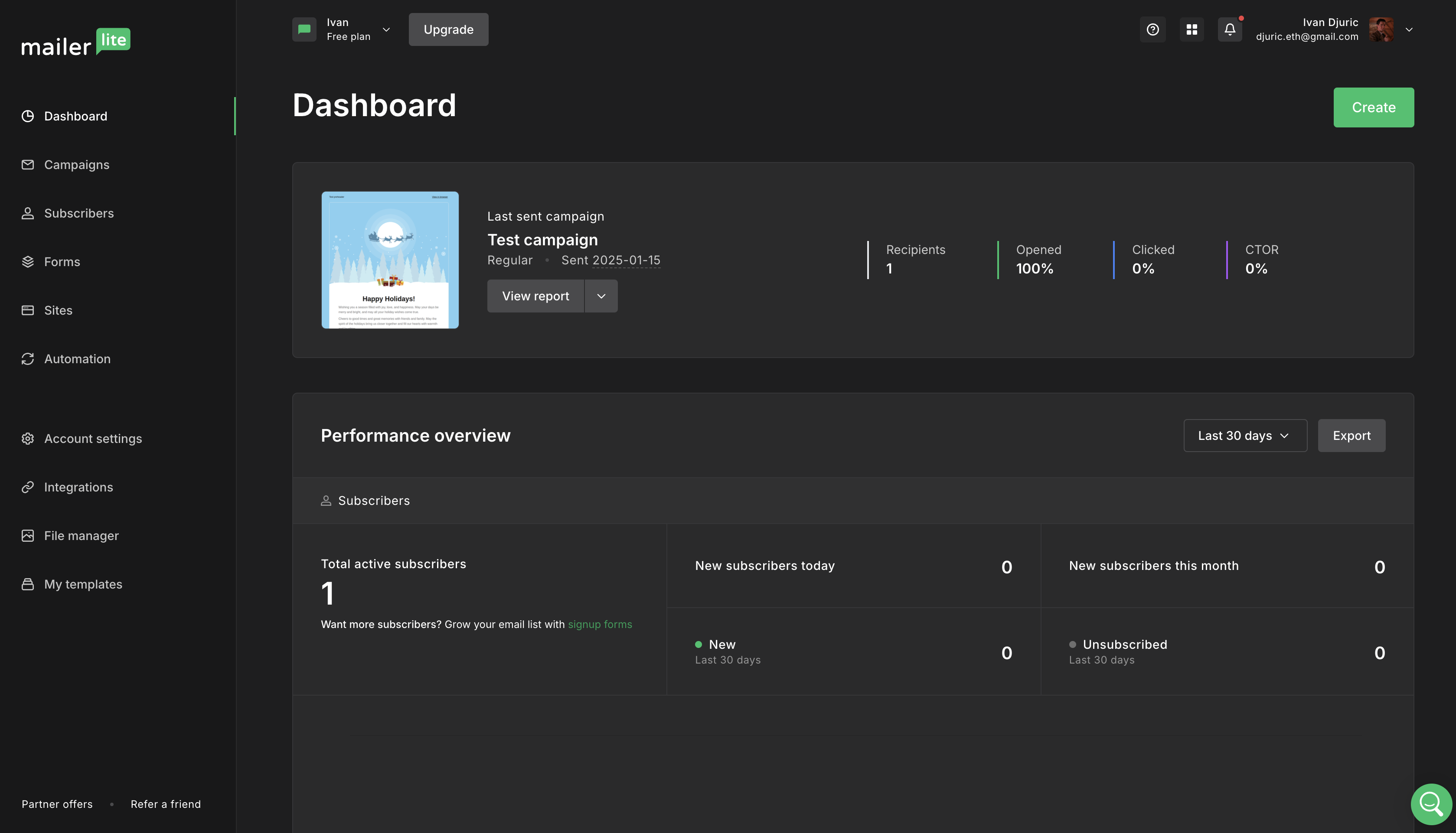
Personally, everything went smoothly with MailerLite, from the moment I created my account to the moment I sent out my first campaign.
However, I’ve noticed people nagging online about their onboarding process:

And while MailerLite’s onboarding process is albeit complicated to some extent (you have to complete a form, verify your domain, and a couple of other things to get going), it’s there so the platform can comply with the international guidelines.
Customer experience
As far as online reviews go, MailerLite is seeing a whole-lotta love all over the web. First, I noticed that it has one of the best ratings on Trustpilot among its competitors.
People also seem to think highly of the platform’s customer support:

Moosend
Free plan: Unlimited email sends for the first 30 days
Moosend is not only an email marketing platform, but also a marketing automation platform. It has a short learning curve, which makes it particularly appealing for SMBs looking for enterprise-level tools that are easy to master and won’t cost a fortune.
Its free plan gives you 30 days to try out all of the core features the platform offers—from advanced pre-made automation workflows and plug-and-play email templates to real-time reporting and A/B testing options.
One of Moosend’s selling points is its drag-and-drop email builder and the vast email library, with templates that actually look good and aren’t there only for show.
Pricing
Moosend’s pricing model is subscriber-based, and each email address counts as a unique subscriber (even if it’s in multiple lists), making it quite scalable. More specifically:
| Plan | Monthly Cost | Email Limit | Contacts | Key Features |
| Free 30-day trial | $0 | Unlimited | Unlimited | Advanced reporting, automation workflows, A/B and spam testing |
| Pro | $9 | Unlimited | Up to 1,000 | Automation workflows, landing pages, subscription forms, SMTP server |
| Moosend+ | Custom | Unlimited | Unlimited | All Pro features, plus your favorite Enterprise features (e.g., Audience Discovery, transactional emails, custom reports) |
| Enterprise | Custom | Unlimited | Unlimited | Deliverability and strategy optimization, priority support, Audience Discovery, dedicated IP |
Pros
- Unlimited emails
- Clean and easy-to-use UI
- No-code functionality on both workflow and email builder
- GDPR-compliant
- Affordable pricing as your list grows
- Built-in AI writer that generates copy for emails and landing pages
Cons
- Limited native integrations
- No phone support
User experience
Moosend has a sleek, minimal dashboard that doesn’t overwhelm you with too many bells and whistles upfront. I was able to sign up and explore the key features without having to go through an onboarding maze or endless tutorial pop-ups.
There were a couple of moments where I had to poke around to find specific information, but the platform offers answers to the most common questions right at the moment you might find yourself stuck somehow.
I was pleasantly surprised when I worked with Moosend’s automation builder. It’s visual, flexible, and it makes setting up triggers and conditions feel intuitive. It also offers automation templates that cover the most common workflows, which you can adjust to your goals.
Plus, Moosend backs everything up with a solid knowledge base that’s clearly designed to keep things frictionless, even if you’re new to email marketing.
Customer experience
The simple and intuitive platform along with the affordable price tag have built a loyal fanbase, especially on review websites like Capterra and G2.
Omnisend
Free plan: 500 email sends per month, 250 contacts, and $1 free in SMS
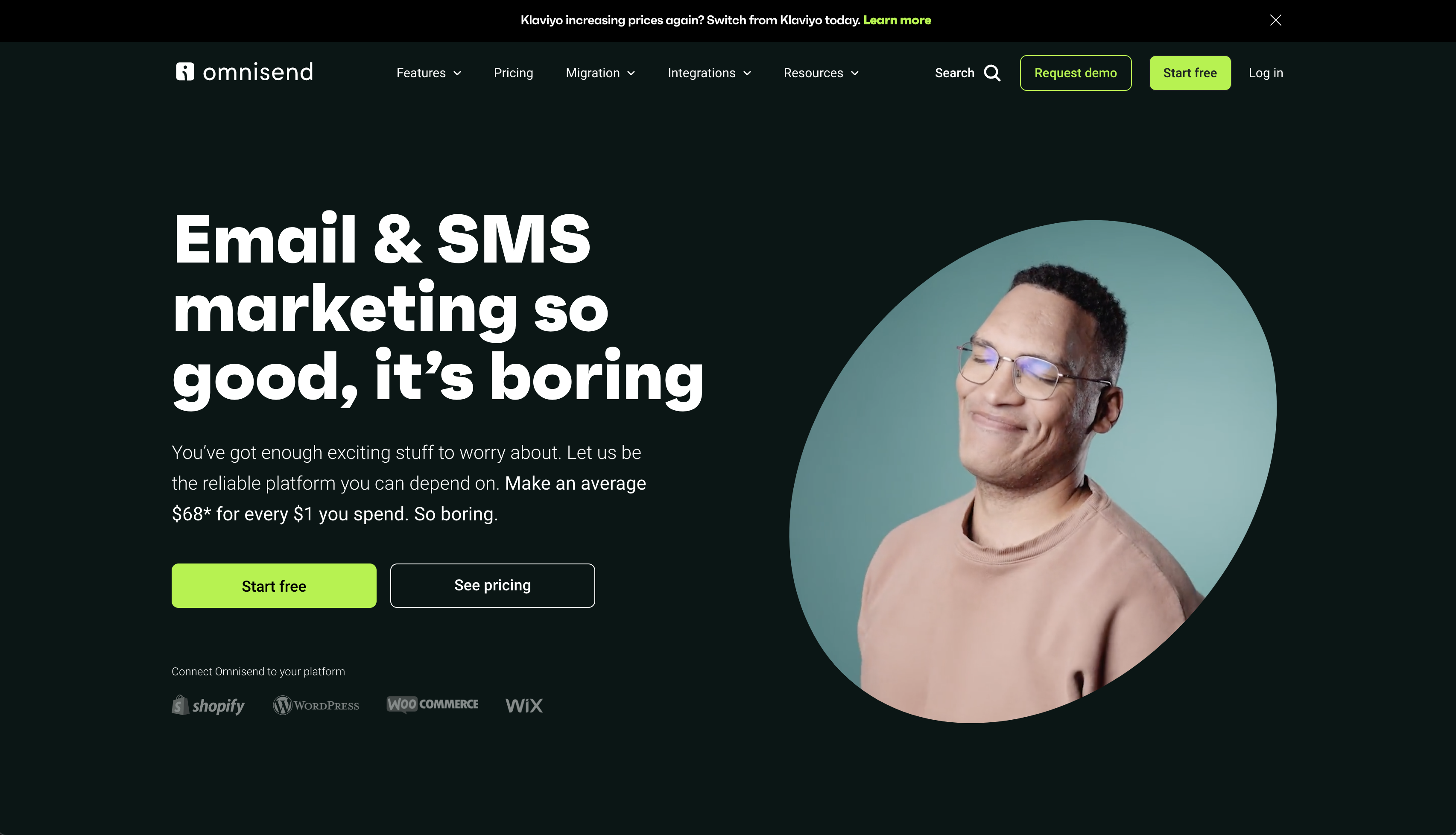
Omnisend is an email marketing and SMS platform that’s best for people who want to combine their e-commerce and email marketing efforts. With the free plan you get a lot of advanced features geared towards online store owners, and some of them include:
- 250+ email templates
- 50 reviews on Shopify
- Pre-built workflows and segments
- Popups, signup forms, and LP creator
- More than 130 integrations
- Sales and performance reports
- A/B testing and automation splits
Now, I must note that the majority of 130+ integrations Omnisend offers are to e-commerce platforms, such as Shopify or WooCommerce. This is a big plus if you’re an online store owner, but if you need CRM or tracking software, you might want to look elsewhere.
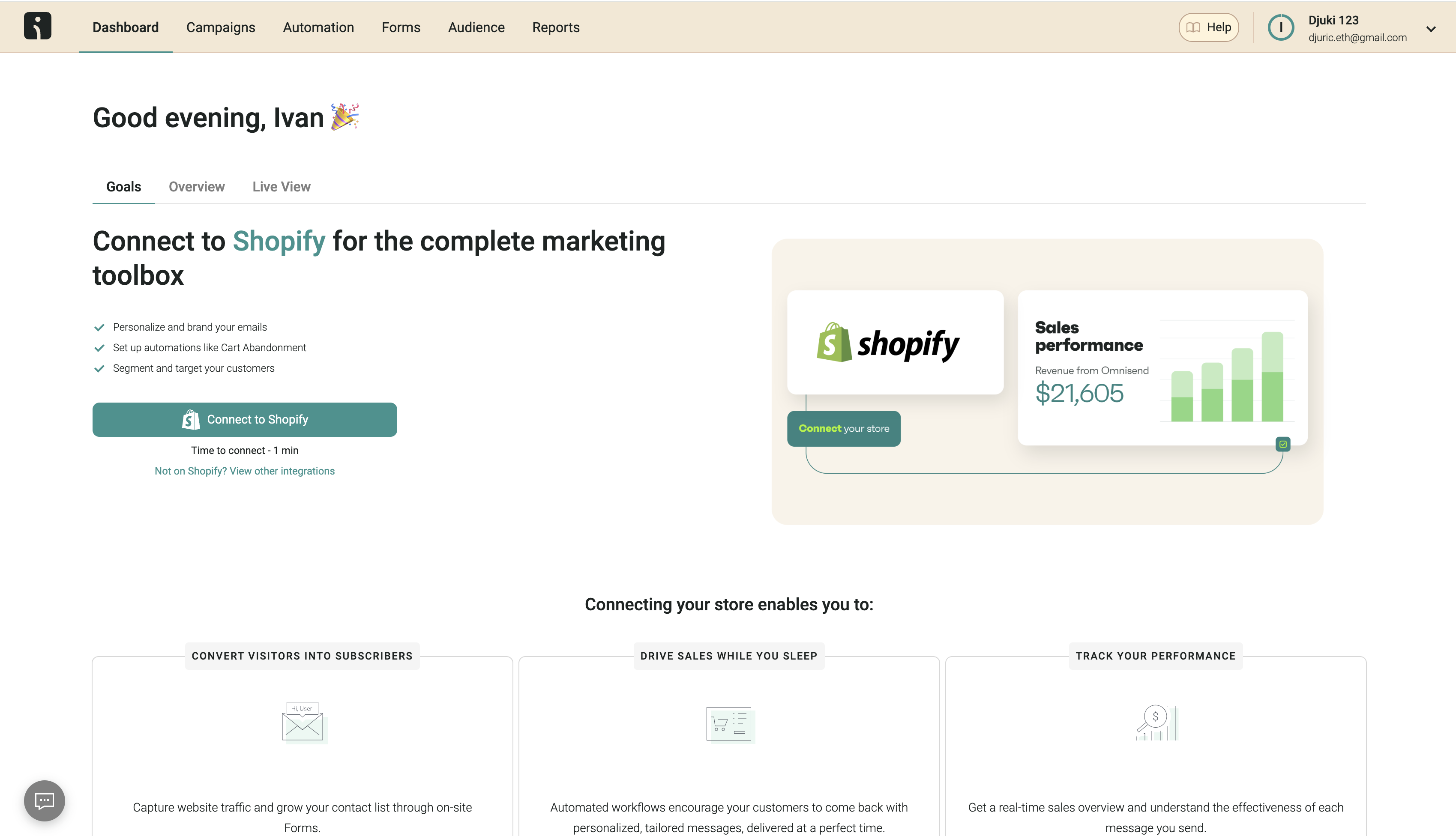
Pricing
When all is said and done, Omnisend’s pricing is quite fair. Check it out:
| Plan | Monthly Cost | Email Limit | Contacts | Key features |
| Free | $0 | 500/month | 250 | Email and form templates/builders, basic segmentation |
| Standard | $16 | 6,000/month | 500 | Advanced automation, A/B testing, 24/7 support |
| Pro | $59 | Unlimited | 2,500 | Priority support, dedicated IPs, advanced analytics |
| High-volume pricing | Custom | Custom | Custom | Custom |
Pros:
- Great segmentation and customer breakdown
- High-quality email templates and forms
- Easy automations
- SMS, push notification, and email tracking
- Free marketing playbook
- 24/7 live chat and email support for all customers
- Basic website builder
Cons:
- Limited email sends and contacts on the free plan
- Few non-ecommerce integrations
User experience
The email templates and forms Omnisend offers look super good, considering they’re free. The only platform that I can think of that has similar ones is GetResponse, which unfortunately didn’t make it on the list.
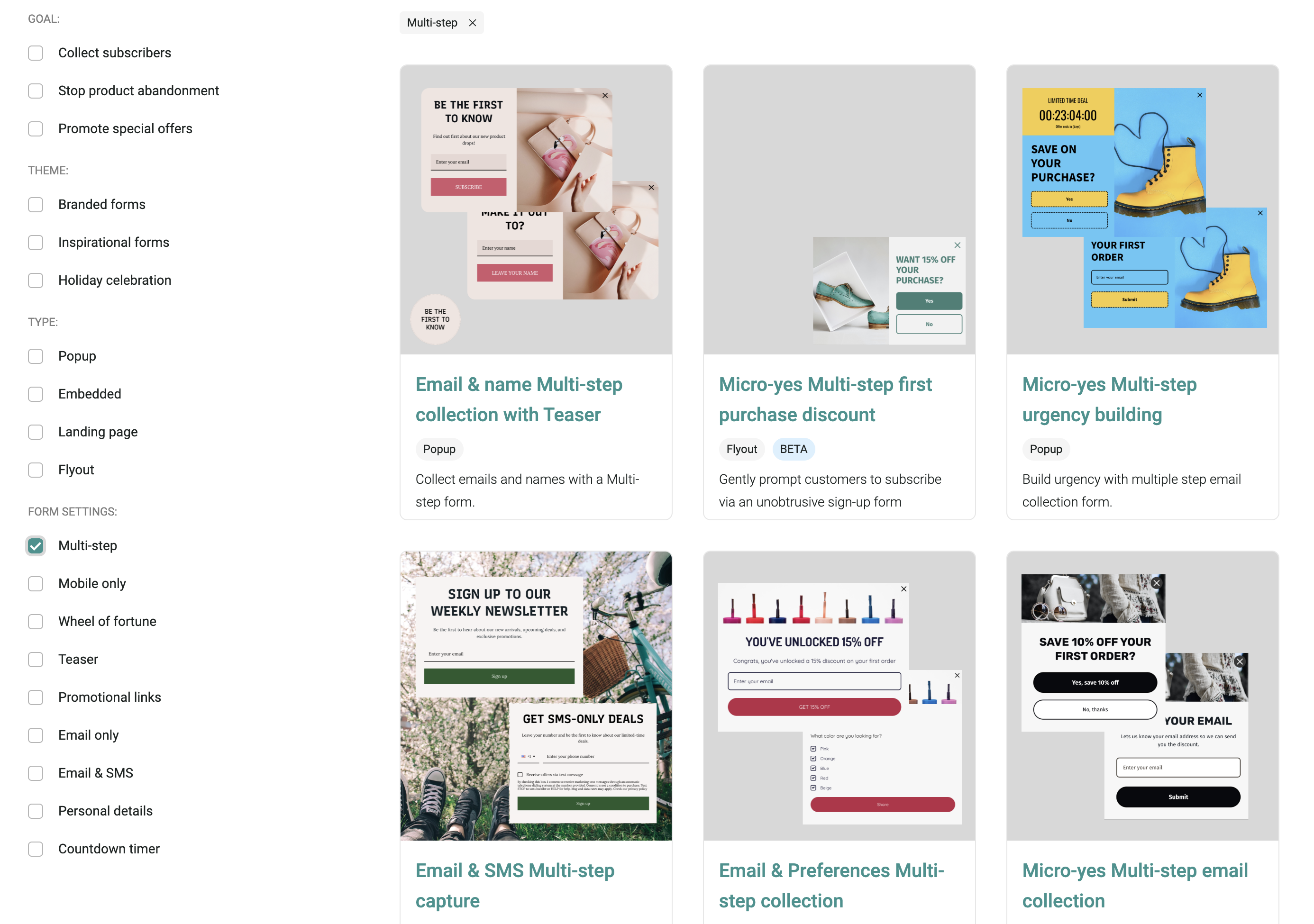
Moreover, the editor is also quite easy to use, regardless of whether you’re designing an email or a landing page. You’ve got your typical elements, like CTA buttons on the left, and you’ve got your theme, audience, and scheduling options on the right.
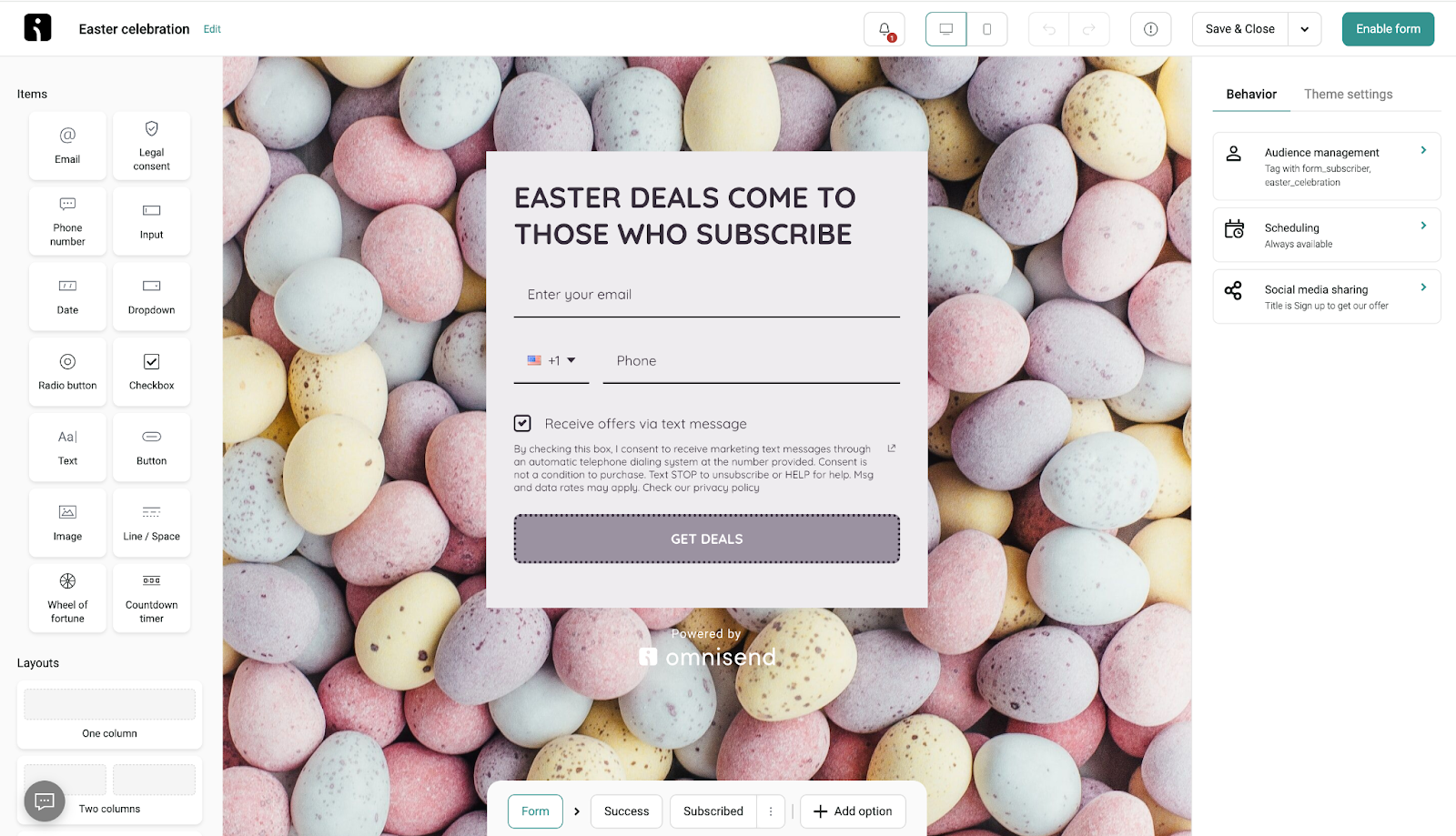
Customer experience
Omnisend seems to take great pride in its customer support, and after spending some time on the web, I can see why. They’re quick to answer, always active, and they’re quite funny on social media.


Klaviyo
Free plan: 500 email sends per month, 250 contacts, and 150 SMS/MMS credits
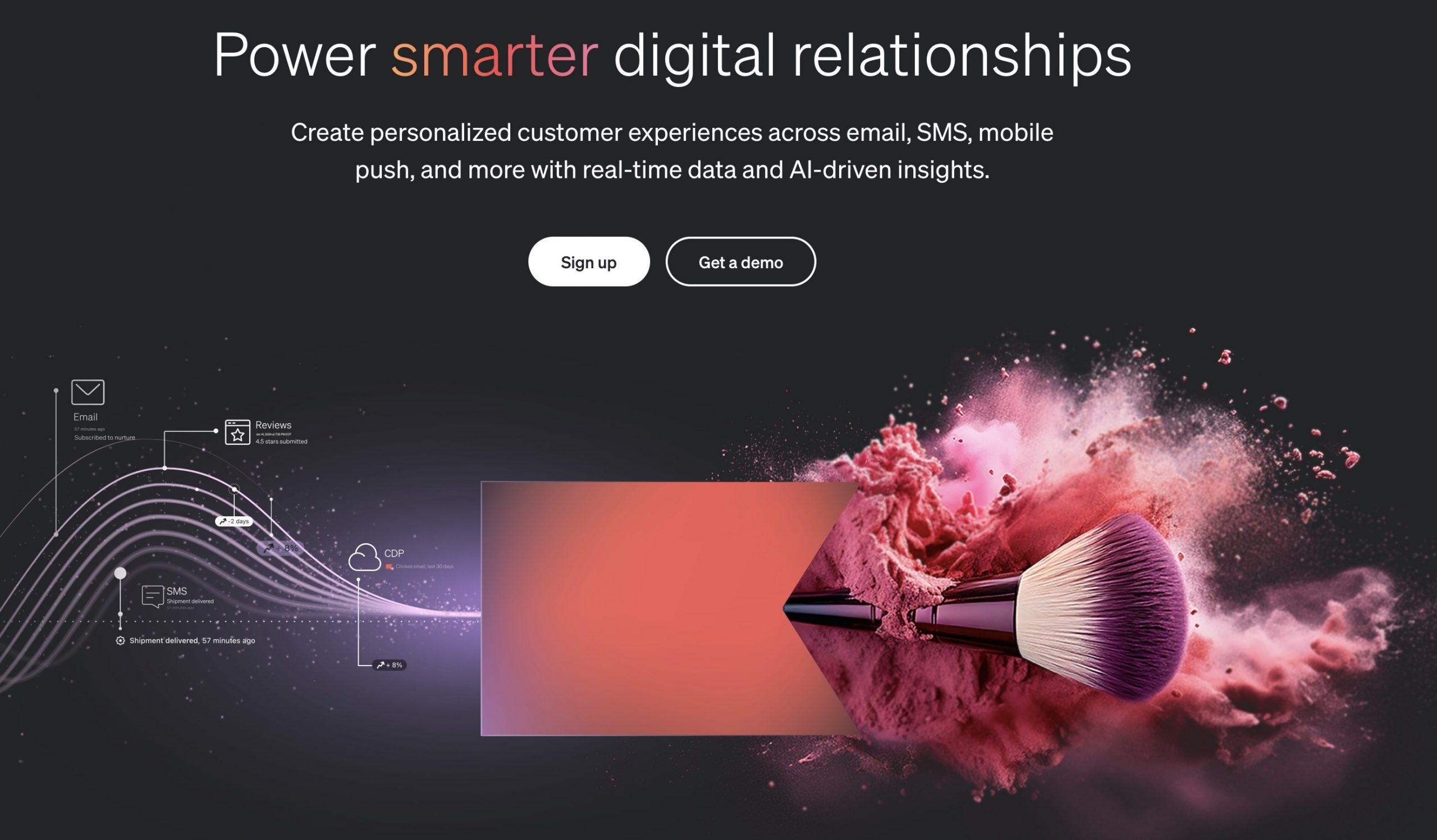
Klaviyo is an email marketing platform for online store owners who want to implement push notification functionality and send SMS messages along with a limited amount of emails on the free plan.
With the free Klaviyo plan, you get access to over 350 integrations, ranging from the usual CRM and e-commerce platforms to shipping & logistics. For example, this allows you to easily sync your customers actions with product data.
You also get the following marketing features:
- Free monthly SMS/MMS credits
- Signup forms, LPs, email templates
- Email marketing automation
- List segmentation
- Email support for the first 60 days
- AI tools for customer behavior
If you’re interested in learning more about Klaviyo’s free plan, they have a nice article on the topic.
Pricing
Recently, as you might know, Klaviyo has decided to upmarket. Here are the updated monthly costs:
| Plan | Monthly Cost | Email Limit | Contacts | Key features |
| Free | $0 | 500/month | 501-1,000 | Email support for 60 days, segmentation, automation, forms, integrations |
| $30 | From 10,000/month | 501-1,000 | All of the above + advanced reporting, A/B testing, advanced AI | |
| Email and SMS | $45 | From 10,000/month | 501-1,000 | All of the above + SMS marketing, advanced segmentation |
Pros:
- Minimalistic design
- SMS support
- Push notifications
- Super easy to use email builder
- Loads of email and form templates
- Automations included in the free plan
- A/B testing for campaign emails
- Solid selection of over 350 integrations
- Great onboarding experience
Cons:
- Not cheap if you have a lot of contacts
- AI tools are unfortunately locked to paid plans
User experience
The first thing I noticed about Klaviyo is its super minimalistic, no-frill dashboard.
The platform also has a great onboarding process that guides you through everything from connecting the platforms you use to importing your contacts and inviting your team.
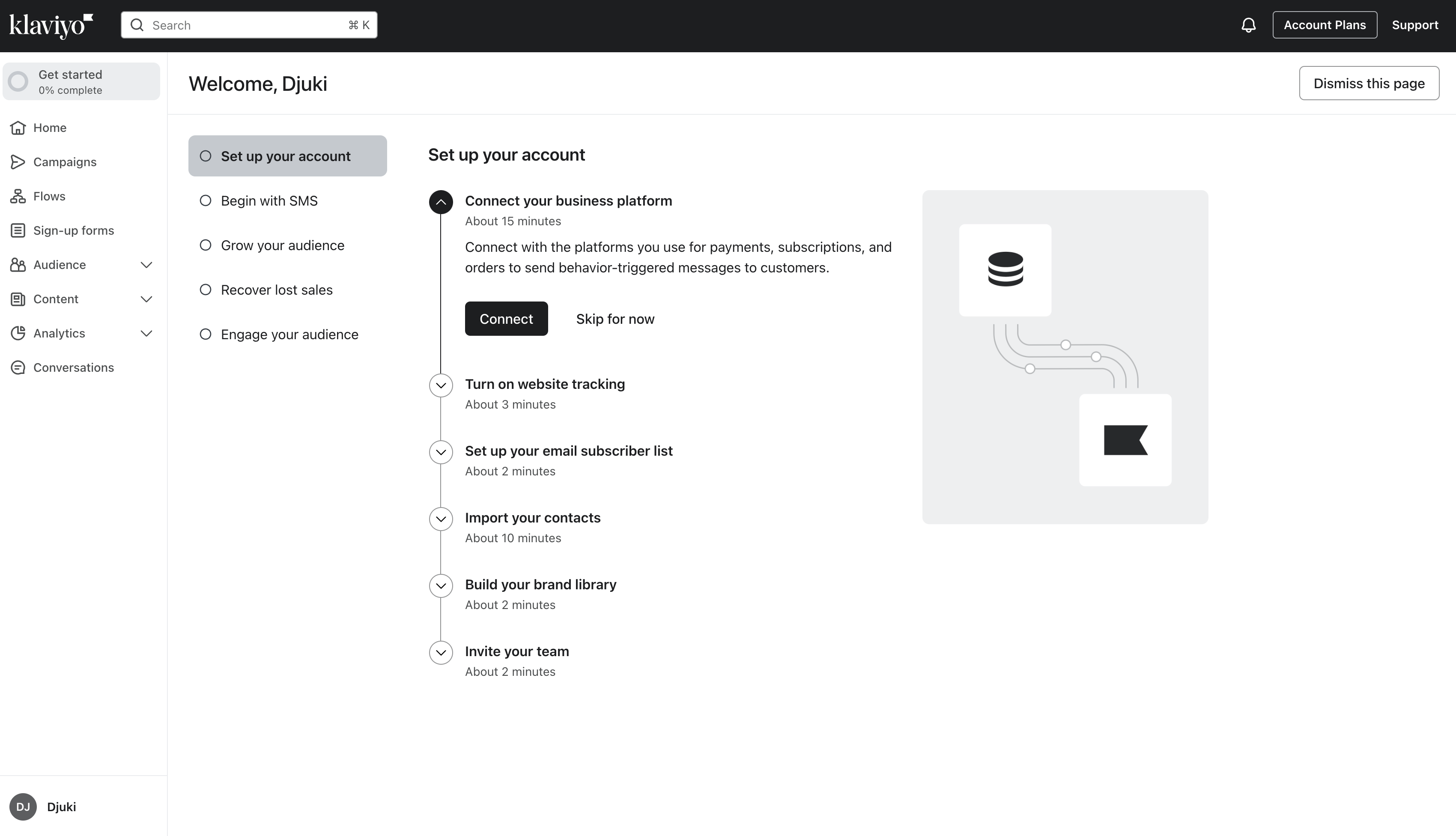
Additionally, I found it’s quite easy to send targeted product recommendations or even user-triggered transactional emails.
I must also say a word or two about Klaviyo’s form templates, since there’s so many good looking ones. Plus, the editor allows you to play around with mobile and desktop versions and it’s super intuitive to use. You click on an element you want to edit, tweak it on the left-side menu, and you’re off!
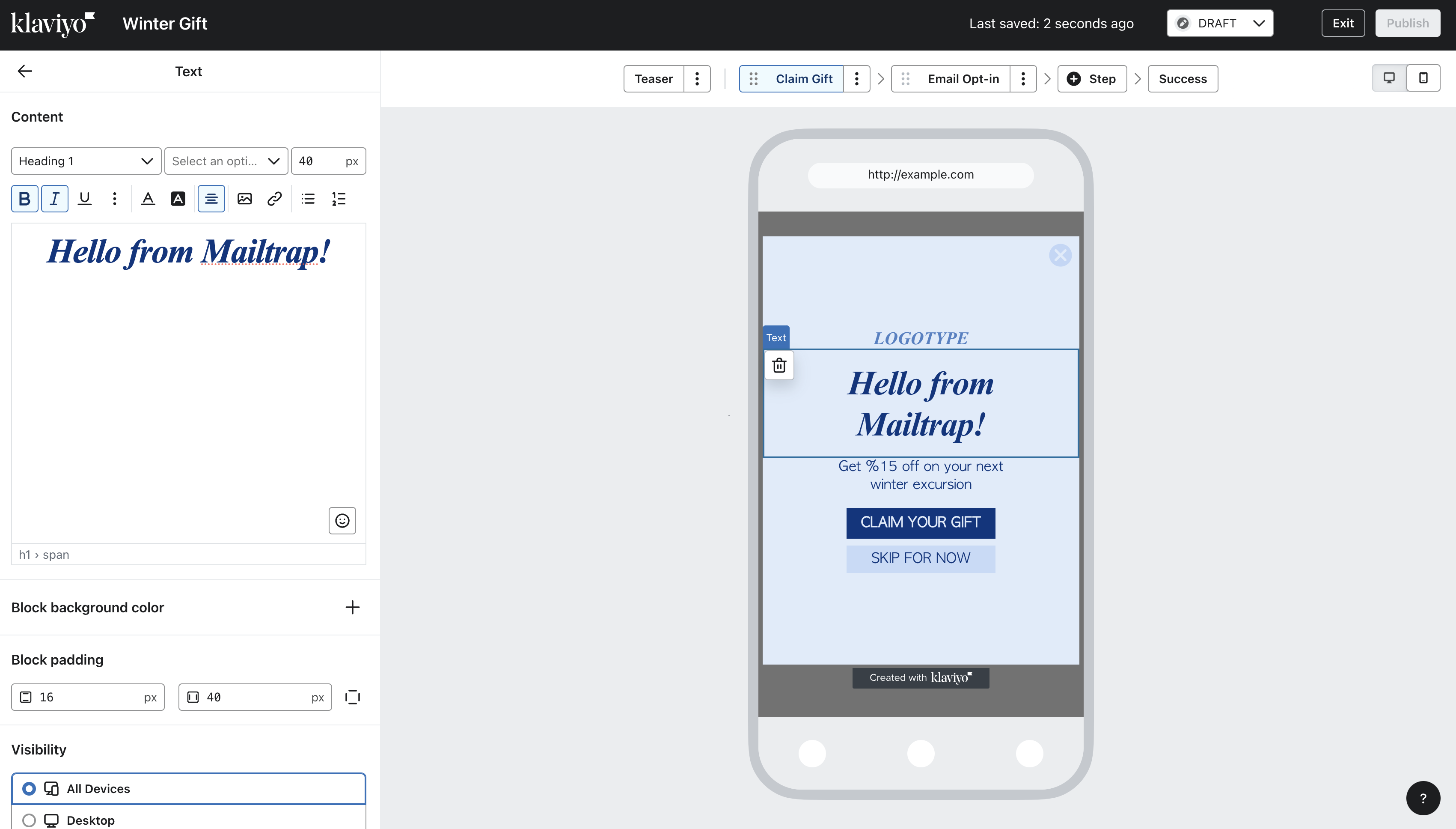
Customer experience
I have also noticed that the customer support team from Klaviyo is always quick to answer on social media platforms, but unfortunately, it’s available only during the first 60 days after you sign up for Klaviyo.
HubSpot
Free plan: 2,000 email sends per month and 1,000 contacts
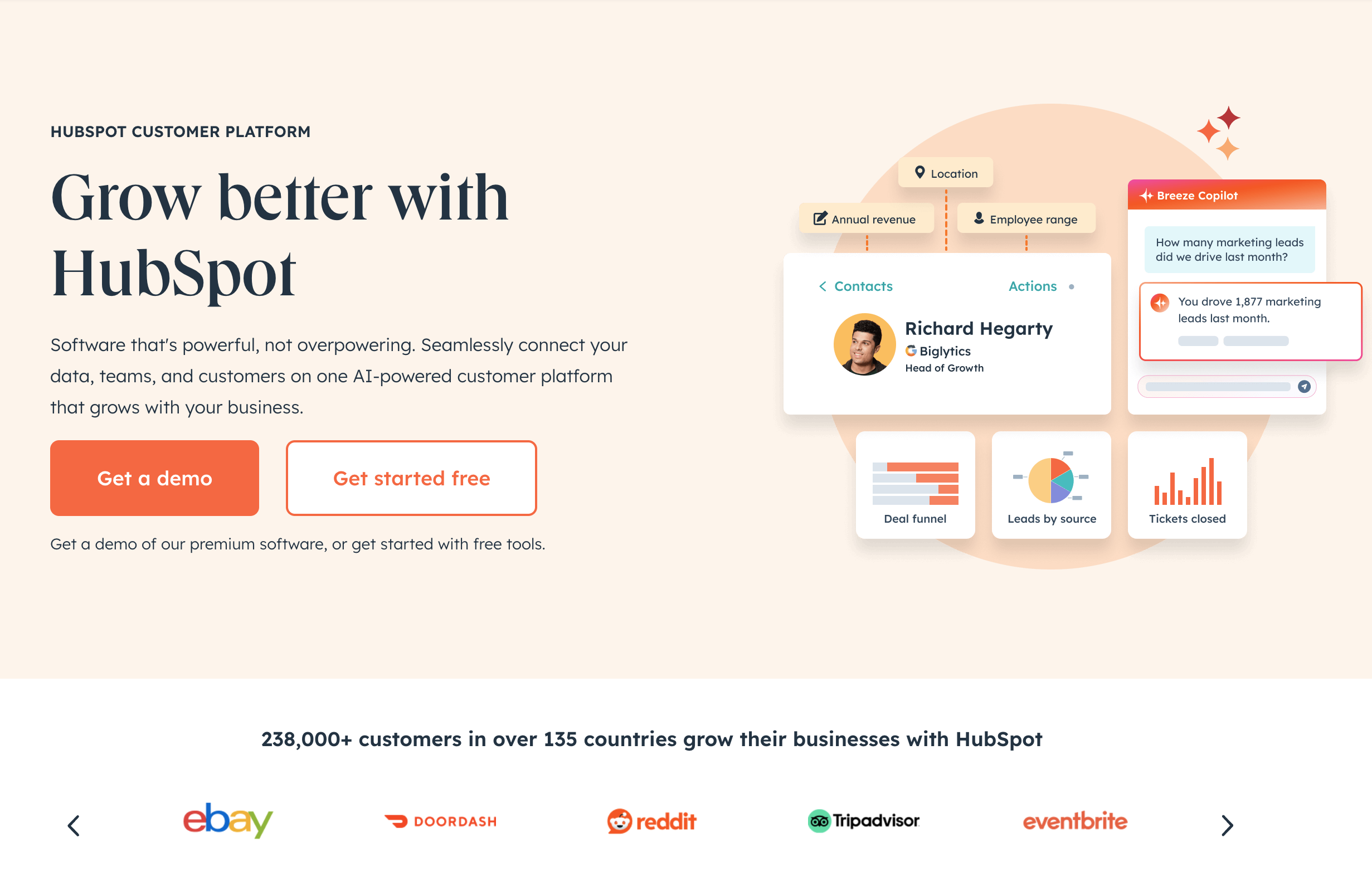
HubSpot is a ‘customer platform’ that, as its name suggests, offers various hubs, one of which is the Marketing Hub, designed to not only deliver emails but also help you with each step of your customers’ journeys.
It’s safe to say that no other platform can beat HubSpot in terms of integrations and number of products. This makes it best suited for businesses and teams who want to have everything in one place.
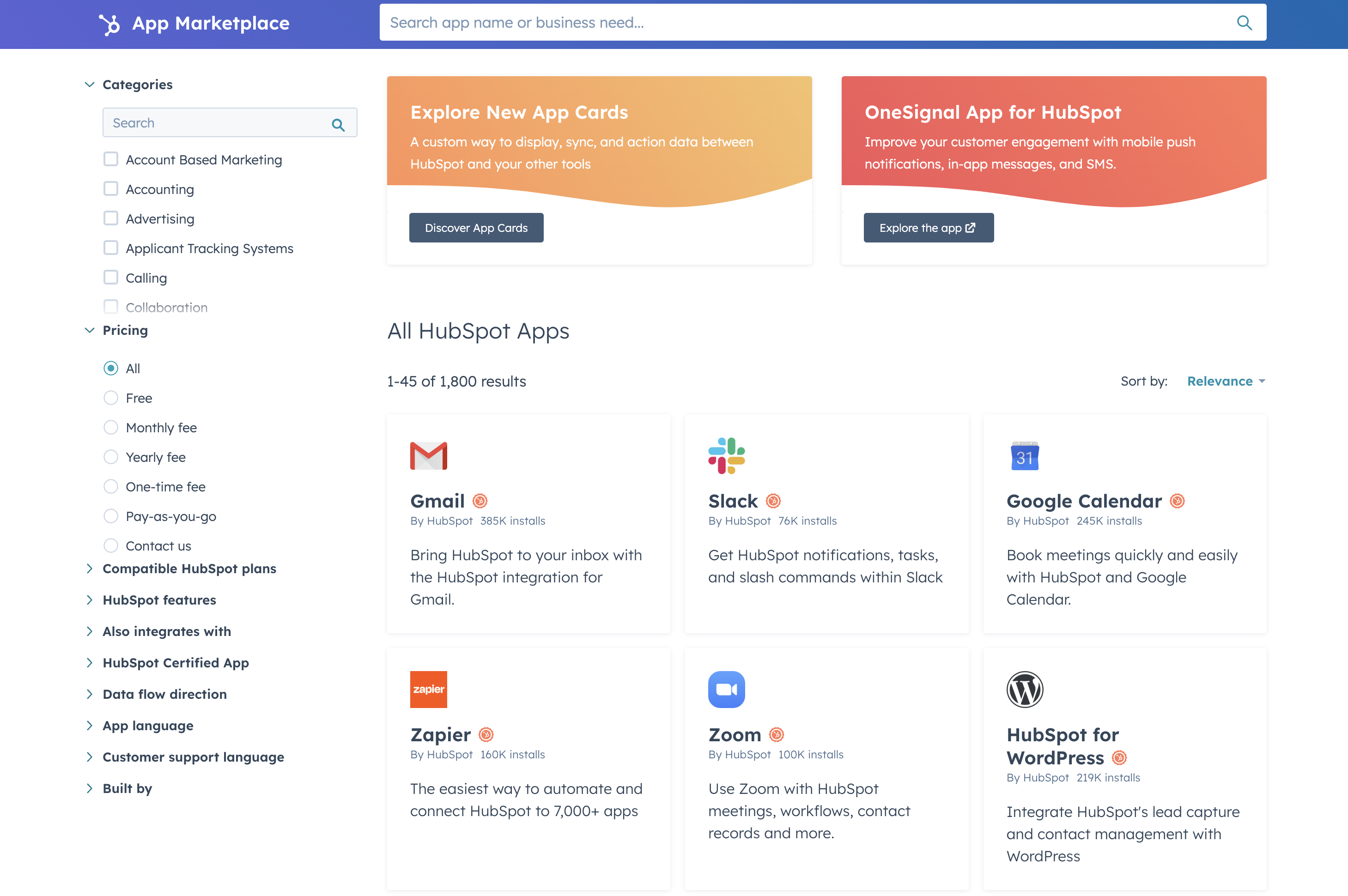
Even the free plan is generous to some extent and allows you to send a limited number of emails every month. You also get an additional feature or two or get a feel of the platform before you settle for a paid plan.
The free email marketing tools you get with HubSpot include:
- CRM integration
- Form builder
- Basic automation workflows
- HubSpot mobile app
- And some more.
You can find out which features from other hubs are available for free by clicking on this link.
Pricing
Switching to a paid plan with HubSpot is similarly expensive to Mailchimp as the former is an all-in-one platform. However, you need to pay for each ‘Hub’ separately.
| Plan | Monthly Cost | Email Limit | Contacts | Key features |
| Free | $0 | 2,000 | 1,000 | 10 active lists, limited CRM integration, web forms |
| Marketing Hub Starter | $20 | 5,000 (5x your contacts) | 1,000 | Forms, live chat, removed branding, email and chat support |
| Starter Customer Platform | $20 | 5,000 (5x your contacts) | 1,000 | Access to service, content, and operation hubs |
| Marketing Hub Professional | $880 | 20,000 (10x your contacts) | 2,000 | All of the above + custom reporting, SMS, lead scoring app |
| Marketing Hub Enterprise | $3,300 | 200,000 (20x y our contacts) | 10,000 | All of the above + custom events, AI social inbox insights, customer, and more |
Pros:
- More than 2,000 integrations
- CRM integration
- Email automations
- Form customization
- Audience segmentation
- Solid customer support
- Can be used by up to 50 accounts, depending on the plan
- Social media management tools
Cons:
- Has a high learning curve
- Pricier than some other platforms out there
User experience
From all of the platforms on this list, HubSpot is probably the hardest one to get a grasp of. However, I will go as far as to say that this is even expected of a platform that has so many suites and features.
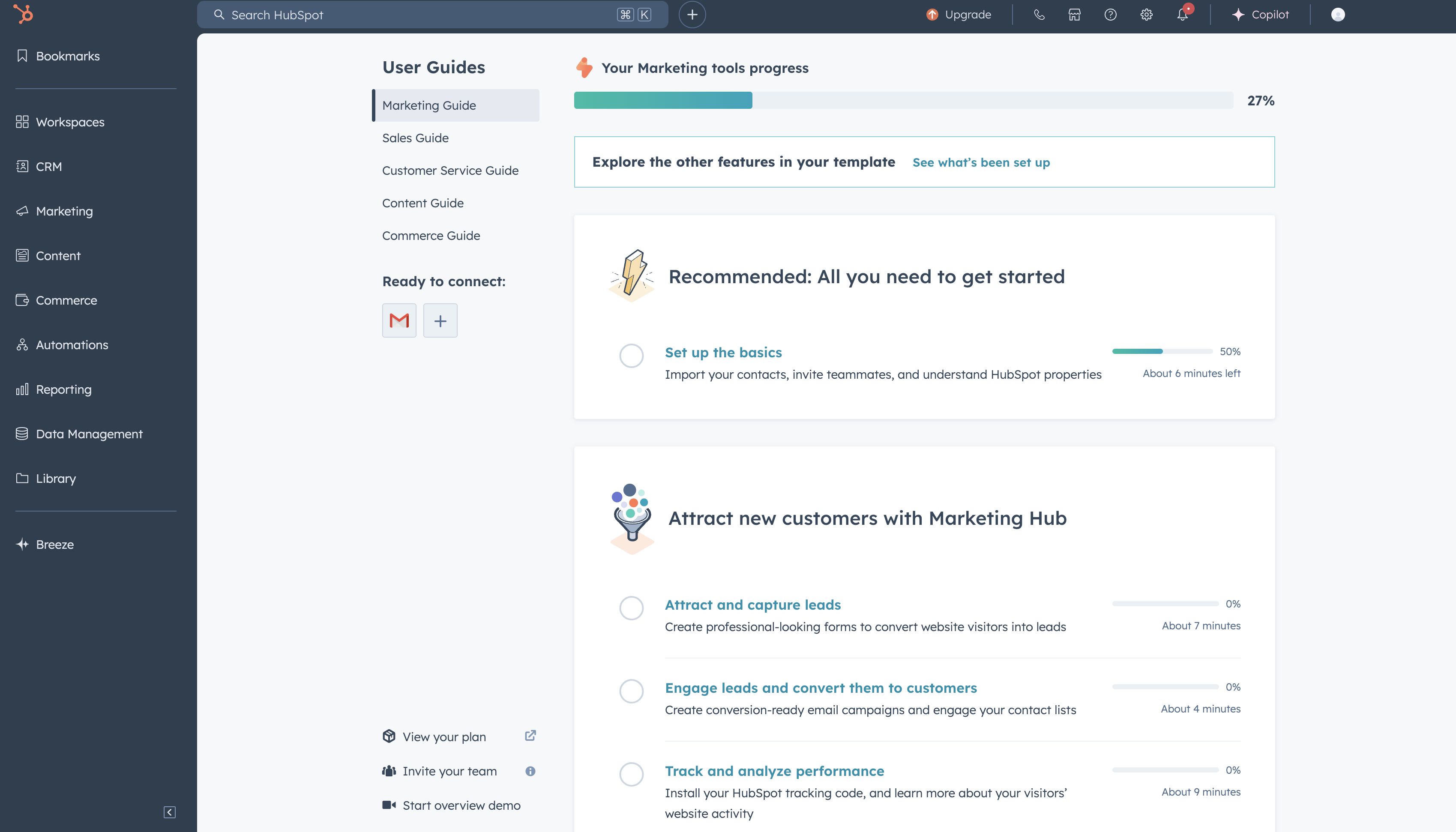
I can compare this steep entry level with ActiveCampaign. So, if you have a team at your disposal or plenty of time to spare, you won’t have an issue with this. Like I said, HubSpot is more for teams than anything else.
Although I have to admit that integrating apps with HubSpot is super easy and straightforward. You can integrate almost any app in ~5 minutes, and I know that’s not the case with many other platforms.
There is also the HubSpot Academy, where you can learn a bunch of useful webinars, lessons, and helpful articles.
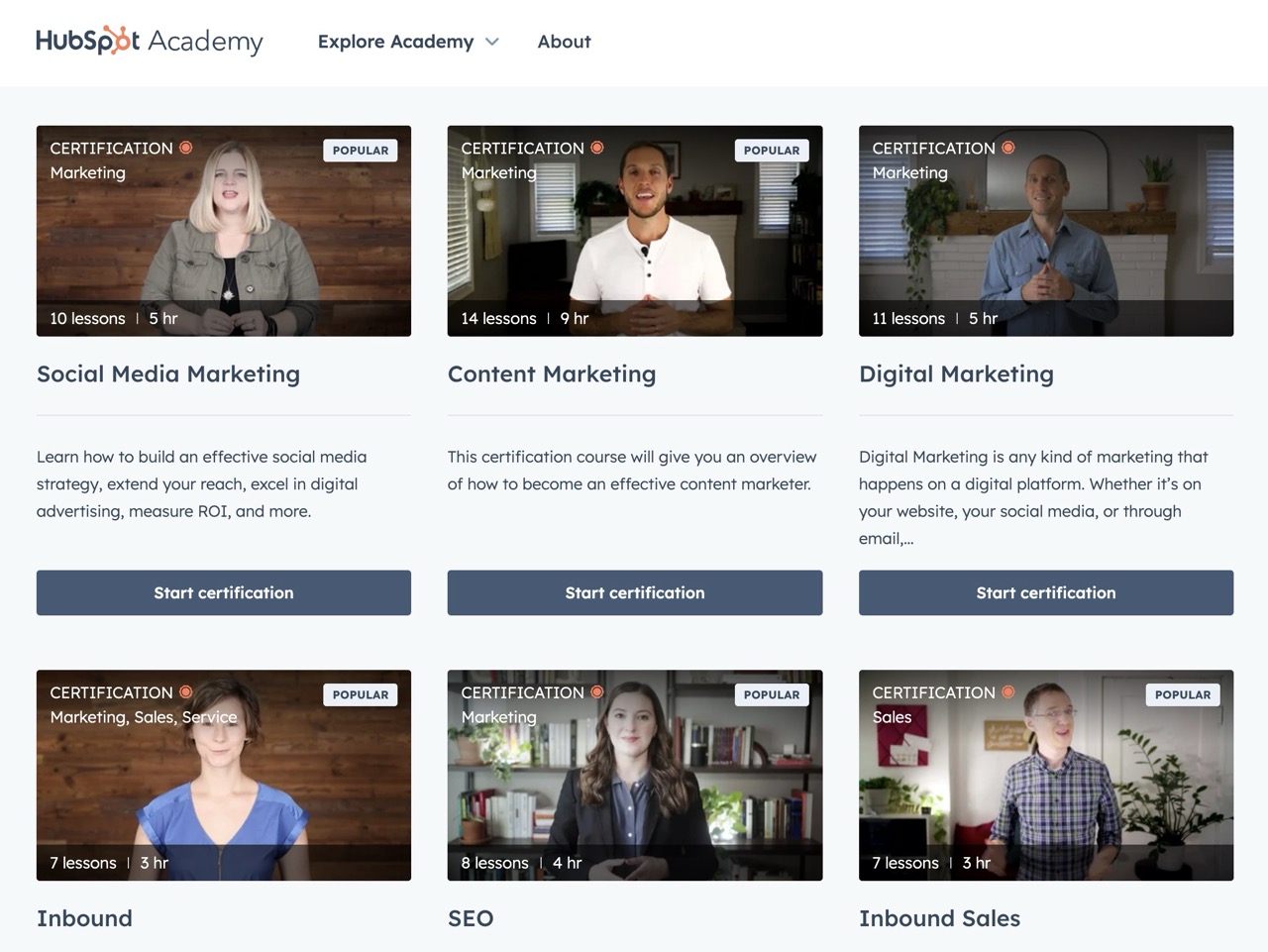
Customer experience
Although it has mixed reviews on Trustpilot, HubSpot seems to be loved by its targeted audience. For example, I found out that Sam Parr, one of the founders of Hampton, used HubSpot for everything related to the project:
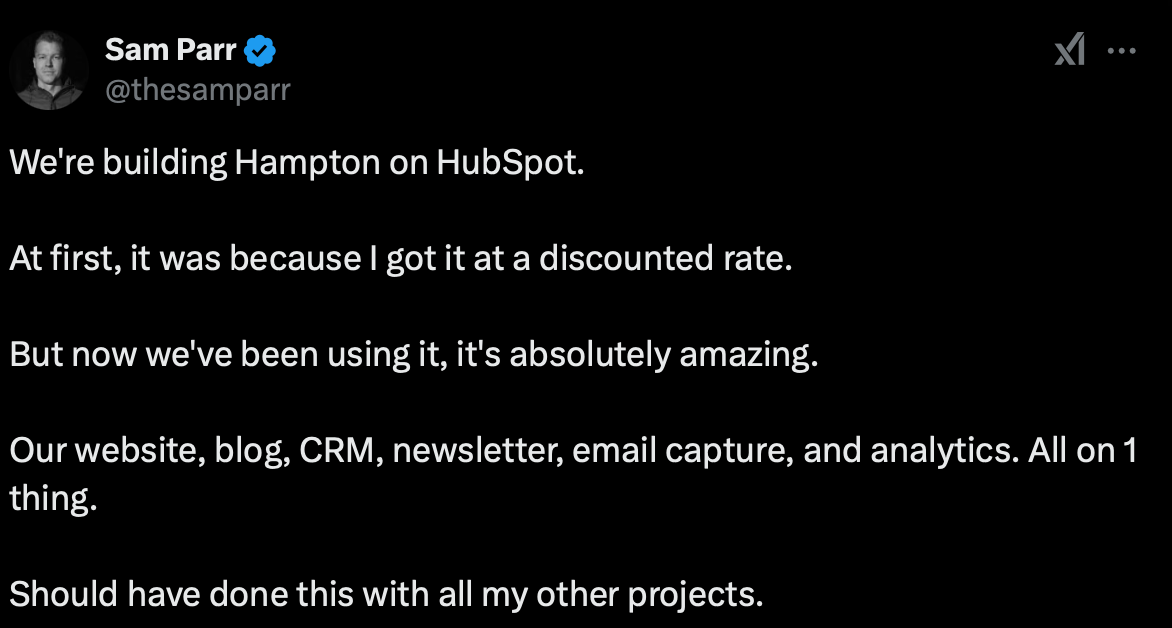
Wrapping up
And we’ve come to the end of our list!
Hopefully, you now have a general idea of what the free email marketing platforms in the industry have to offer. The keyword here is free, so don’t be afraid to try them all out, see which one fits your business the best, and start sending them emails! 📨
P.S. If you’re interested in expanding your email marketing knowledge, be sure to check out our blog, where you can read articles such as:
- Why Email Marketing Is Important
- 19 Email Marketing Best Practices
- 7 Best SMTP Service for Email Marketing
Want to explore more free email marketing platforms? Check out our dedicated video linked below:



